Saint-Rémy-de-Provence lies in the beautiful countryside against the backdrop of the Alpilles range. Lush green fields with sturdy cypresses and poplars surround the delightful country town. In this article, I have included a 1 km self-guided walk across the streets of the old town to help you discover all the exciting places.
Watch our short video presentation of Saint-Rémy:
My first visit to Saint-Rémy-de-Provence
I remember the day I first visited Saint-Rémy-de-Provence.
I had heard of the little town and seen lovely pictures.
When we finally had the chance to explore the Provence region, I had it on my to-do list.
Saint-Rémy has this magic that appeals to many visitors… including Van Gogh!
If you’ve never been to Saint-Rémy, you’re in for a treat.
It is full of quiet corners, such as the shady square of Place Favier.
Several pleasantly aged buildings contain much history within their stones.
You’ll love this delightful town packed with superb little streets, restaurants and boutiques.
Saint-Rémy-de-Provence: the capital of the Alpilles
Saint-Rémy was built at the foot of the Alpilles mountain range.
The town lies in fields and orchards planted with soft fruit, vegetables and flowers.
Each field is a barricade of sturdy cypresses, poplars, or bamboo lashed together to form a fence.
Irresistible!
Also, before leaving Saint-Rémy, make sure you visit the Roman ruins.
They are found south of the town, at the foot of the Alpilles.
There is the mausoleum and triumphal arch at Les Antiques and the formidable Roman city of Glanum.
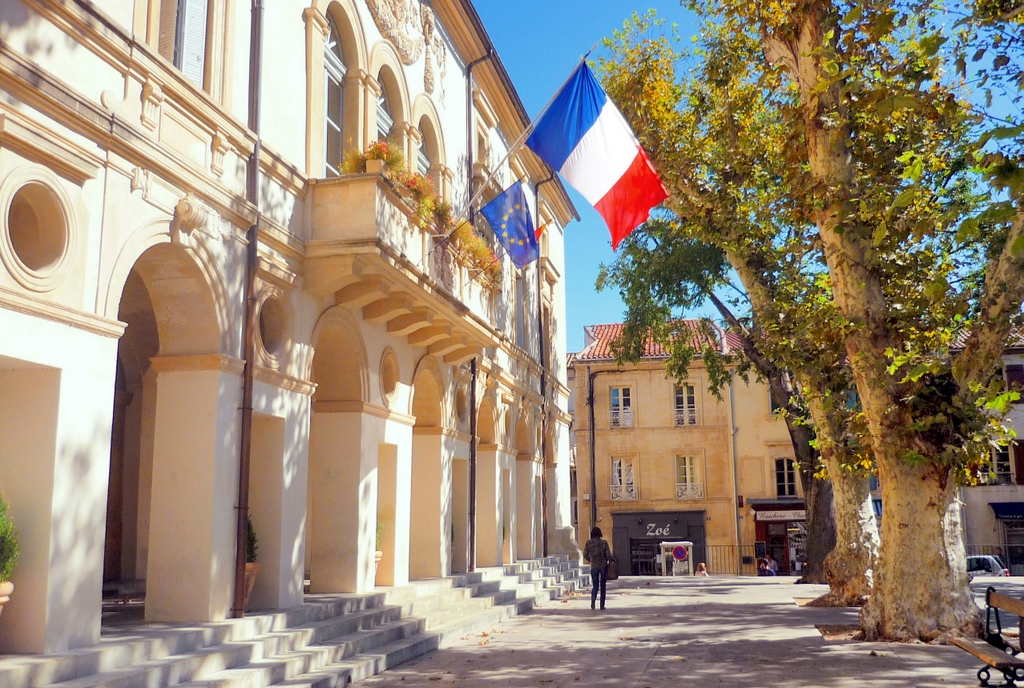

Saint-Rémy: A rich cultural past
Since the Old Regime, Saint-Rémy has had a cultivated elite with the presence of a small college run by the Trinitarians. With this favourable context, the Provençal town has had a particular intellectual vocation since that time, which has continued to develop to this day.
Saint-Rémi attracted artists and intellectuals at an early stage: the memory of Nostradamus, the richness of its heritage and the beauty of its landscapes.

Because of its proximity to Arles, Vincent van Gogh stayed in the Saint-Paul de Mausole nursing home (1889). In Saint-Rémy, the Dutch painter produced some of his best-known works, further enhancing the town’s reputation. Other artists would later come to stay or settle in Saint-Rémy, such as René Seyssaud (1867-1952), Jean Baltus (1880-1946), Albert Gleizes (1881-1953), André Hambourg (1909-1999) and Mario Prassinos (1916-1885).
With the Provençal renaissance initiated by Frédéric Mistral (1830-1914) in the 1850s, Saint-Rémy became the nerve centre of this movement, as did its neighbours Maillane, Avignon and then Arles. Frédéric Mistral himself was of Saint-Rémy origin through his father.
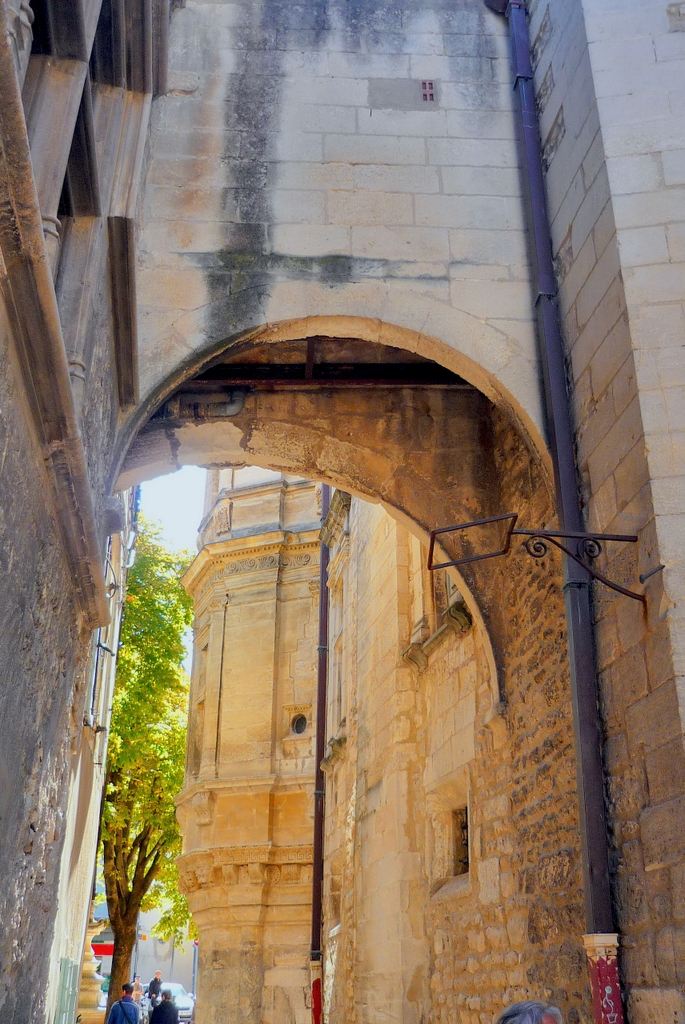
Although the town has unfortunately lost much of its agricultural vocation, Saint-Rémy-de-Provence has become a favourite holiday destination. Indeed, many tourists and personalities appreciate its enchanting setting more than ever.
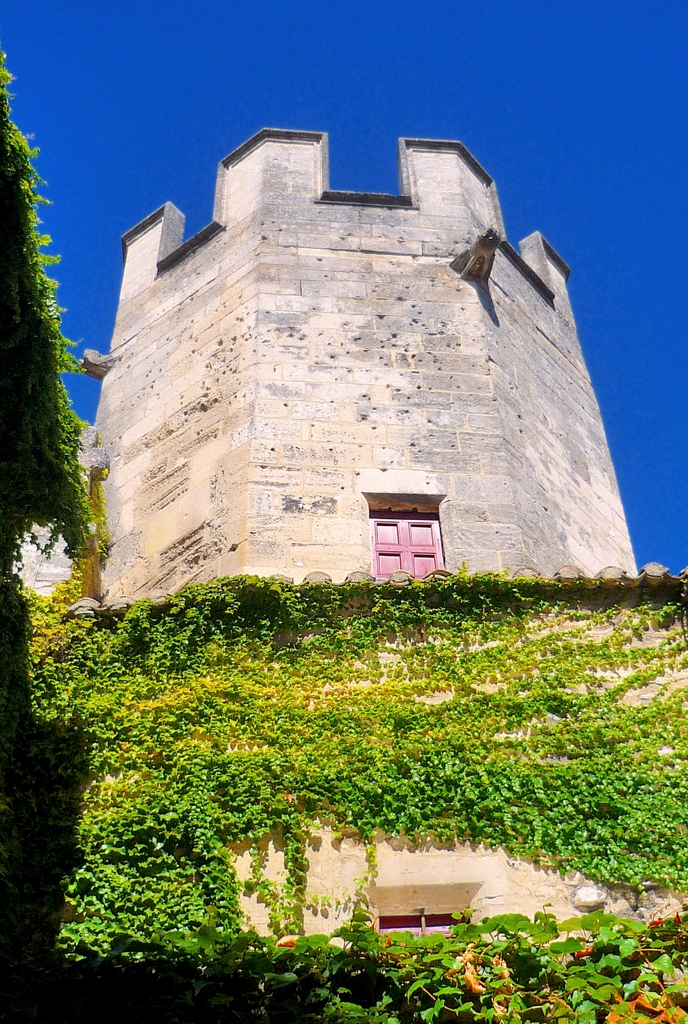
Where to stay in Saint-Rémy-de-Provence?
There are more than a hundred places where you could stay in Saint-Rémy-de-Provence.
Here are some of the finest places, according to booking platforms reviews:
Le Saint Rémy****
It is a luxurious hotel with excellent decoration and modern rooms. Ideally set in the centre of town. Book your room!
Hôtel de l’Image****
Located in the heart of Saint-Rémy, the hotel is set in a 2-hectare garden looking out into the Alpilles. Book your room!
Le Mas des Genêts (Holiday home)****
This spacious holiday home is in a fantastic location with two bedrooms, a kitchen, a bathroom, a beautiful garden, and an outdoor swimming pool. Book your vacation!
Click here to get a list of hotels and accommodations in Saint-Rémy.
This map will help you book your accommodation in Saint-Rémy according to prices and locations.
Visit the old town of Saint-Rémy-de-Provence
Busy and shaded boulevards enclose the old town of Saint-Rémy-de-Provence. The centre is about half a kilometre in diameter.
Medieval houses line the streets of the old town and lead you to quiet little squares shaded by remarkable plane trees.
You’ll see old fountains at the crossroads of two narrow cobbled streets, old buildings, boutiques, and Provençal-style restaurants that will undoubtedly charm you!
Watch my Guided Walk of Saint-Rémy-de-Provence
A 23-minute video that explores the historical old town with its ancient streets and charming squares.
Click here or on the map below to view the itinerary on Google Maps (approximately 1 km long).
1. Place Jean Jaurès and the Tourist Office
The discovery of the old town starts at the Tourist Office in Place Jean Jaurès. This is where we parked our car.
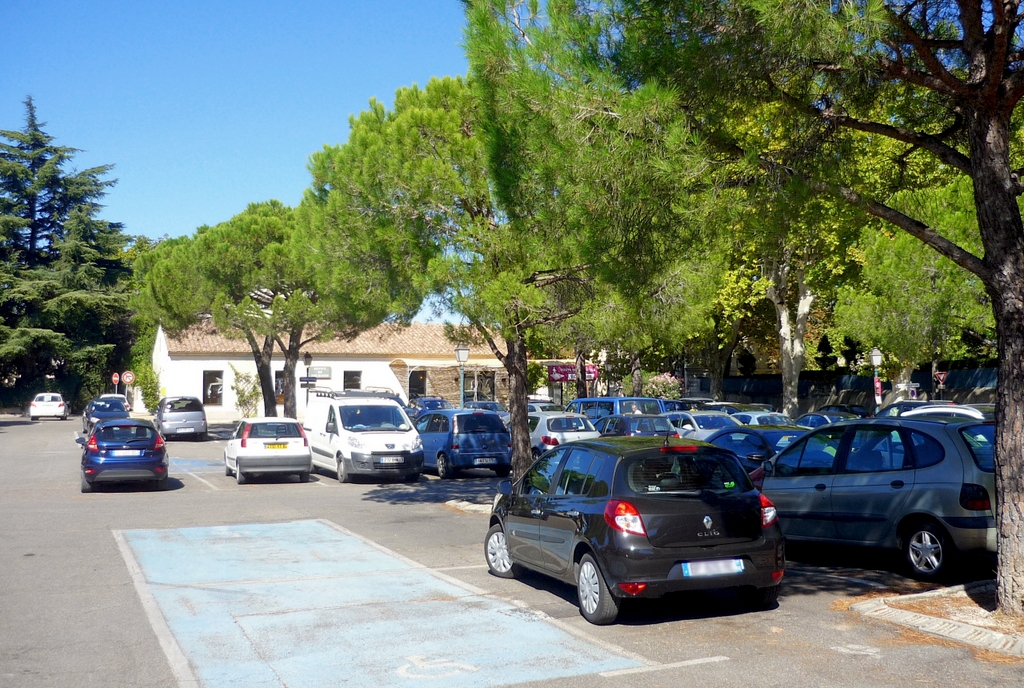
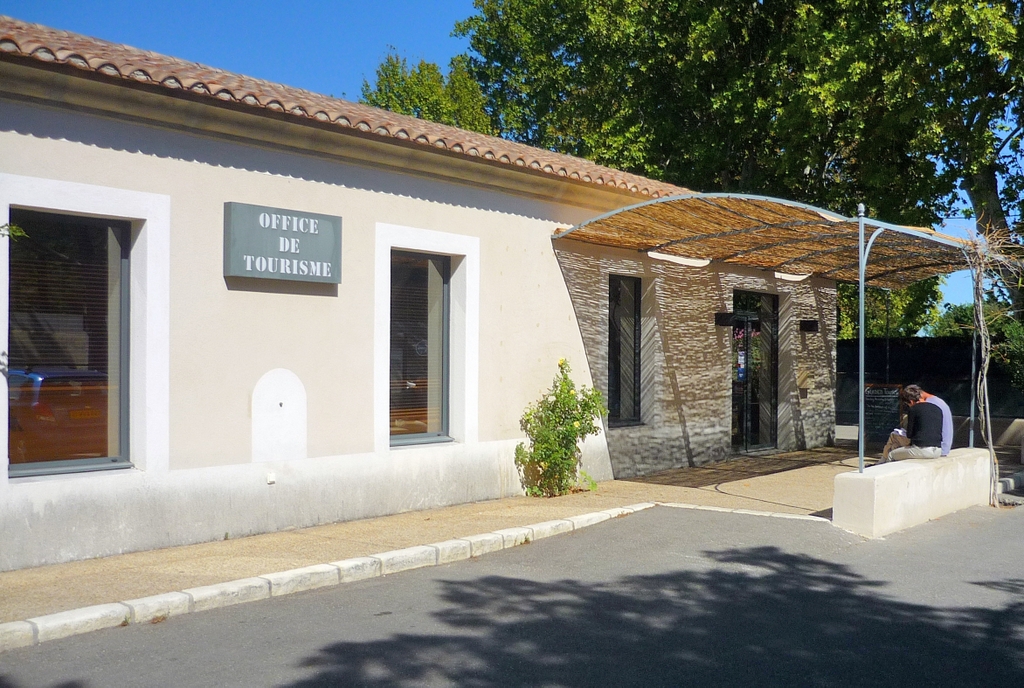
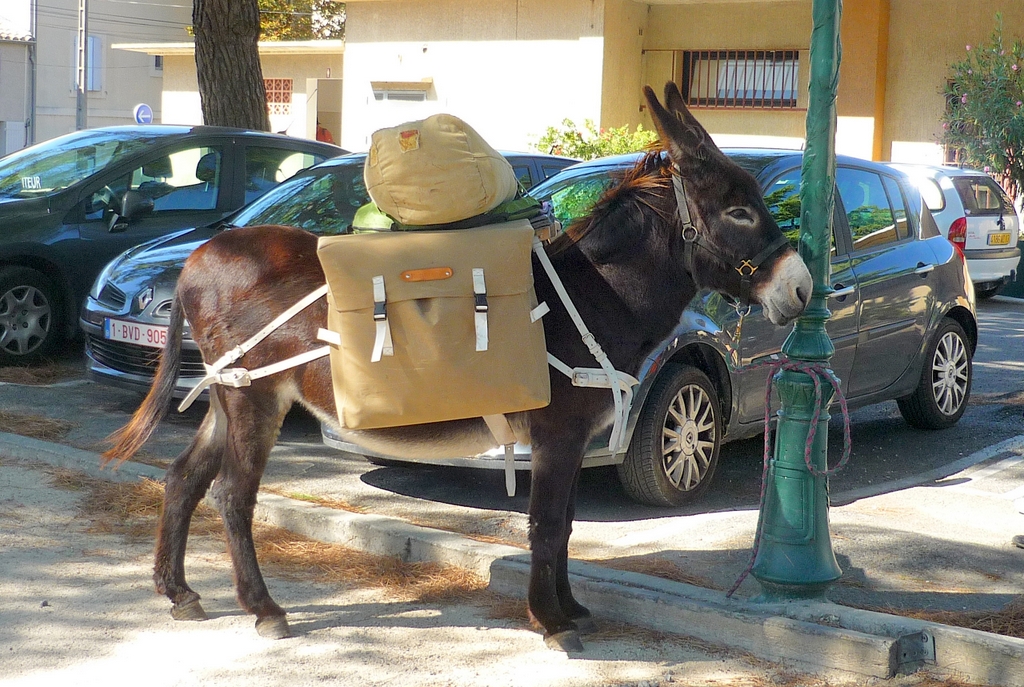
Walk onto Avenue Pasteur and go under the archway that leads to the Rue de la Commune.
2. The Saint-Paul Gate
The Saint-Paul Gate (Porte Saint-Paul or Lou Portau de San-Pau in Provençal dialect) gives access to the old town of Saint-Rémy-de-Provence.
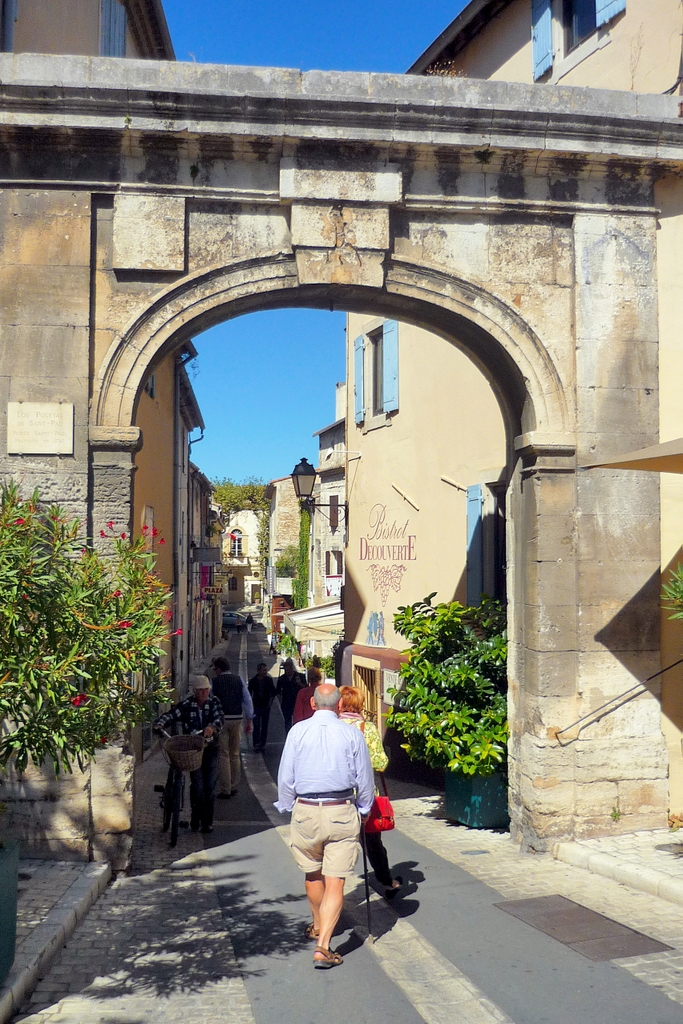
Walk 100 m along the Rue de la Commune to reach the town’s main square, Place Pellissier.
3. Place Jules Pellissier and the Town Hall
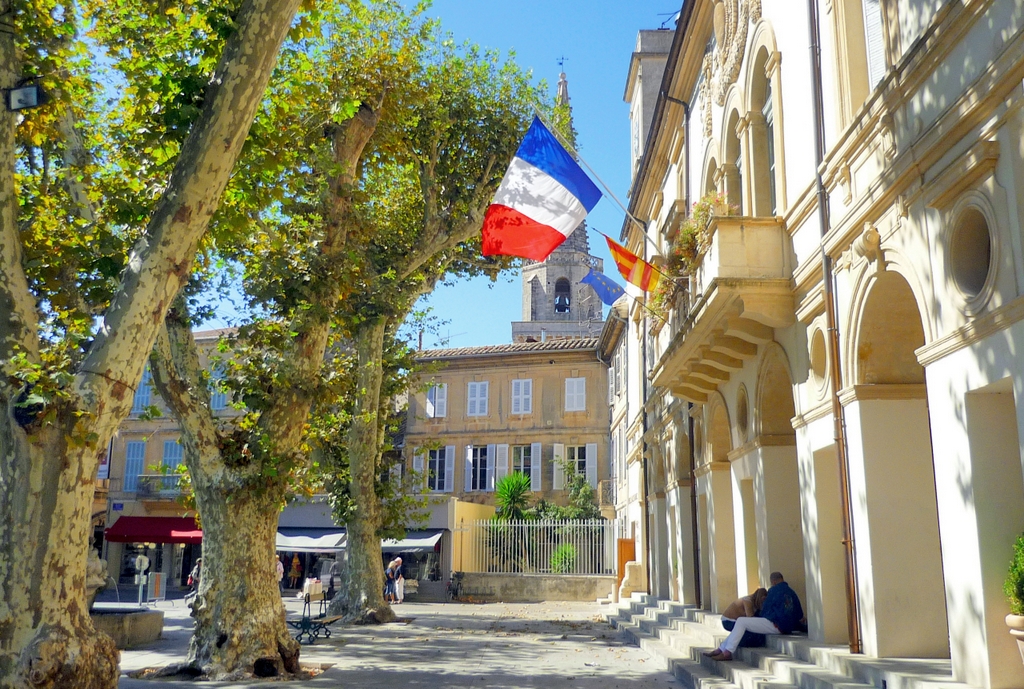
Place Jules Pellissier lies in the centre of the old town. The shady square dates back to 1793, on the site of a former convent. It gave way to the town hall and its belfry.
In its centre stands the Fontaine des Quatre Dauphins (fountain of the four dolphins). Inaugurated in 1814, it is dedicated to King Louis XVIII. It was inspired by the fountain with the same name in Aix-en-Provence.

You’ll love coffee or an ice cream under the 100-year-old plane trees!

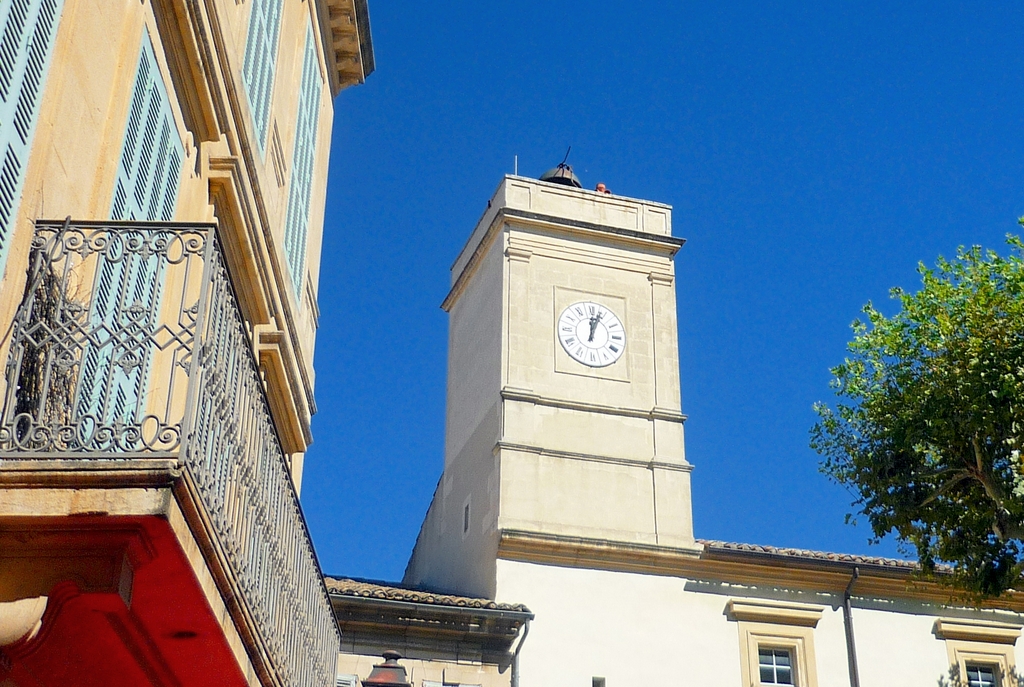
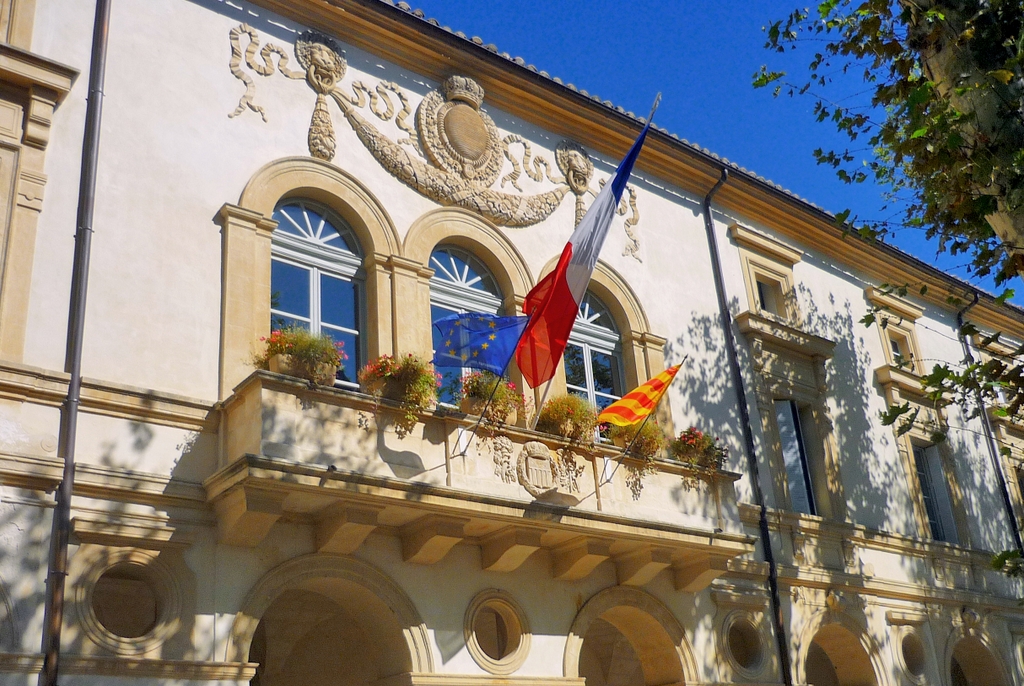
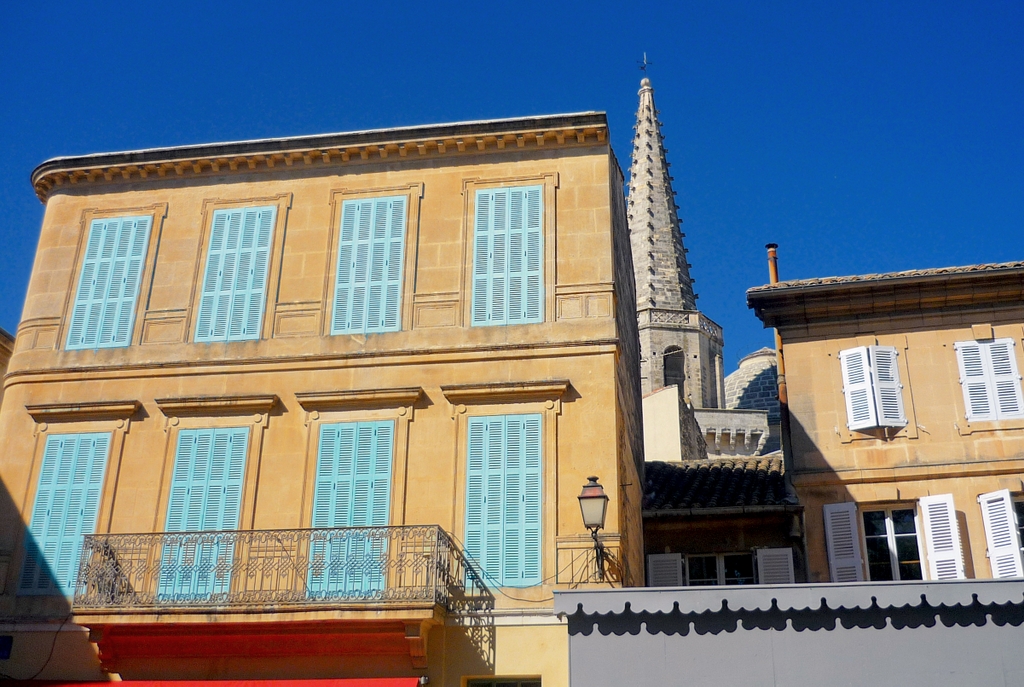
Walk to the right of the square to reach the Rue Jaume Roux. Immediately turn right towards the Rue Lucien Estrine by walking under the arch.
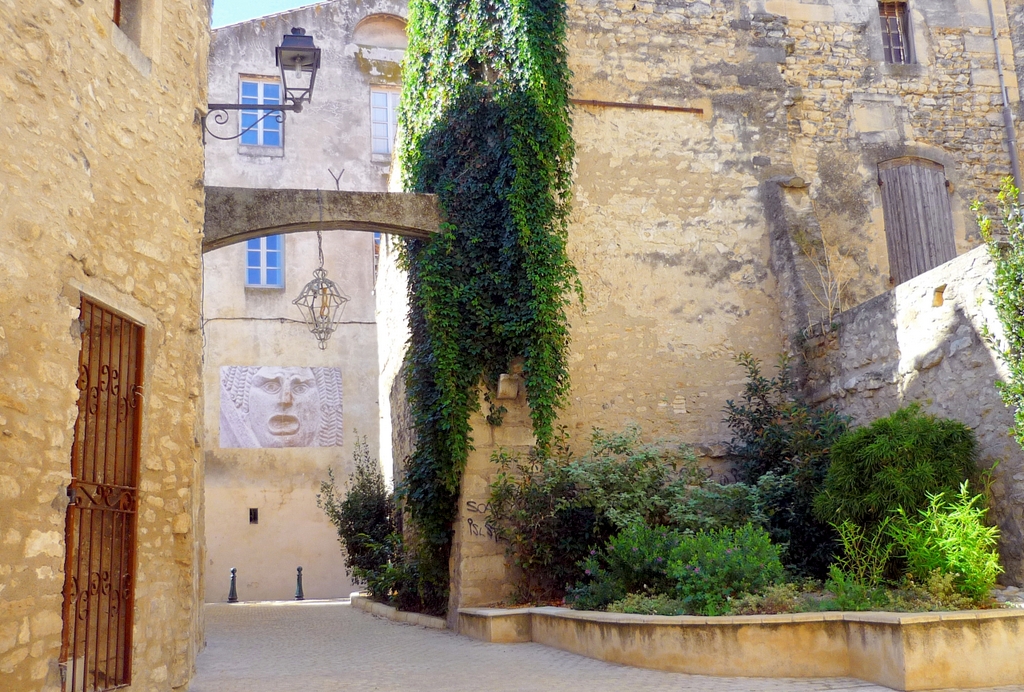
4. The Hôtel Estrine and its Van Gogh museum
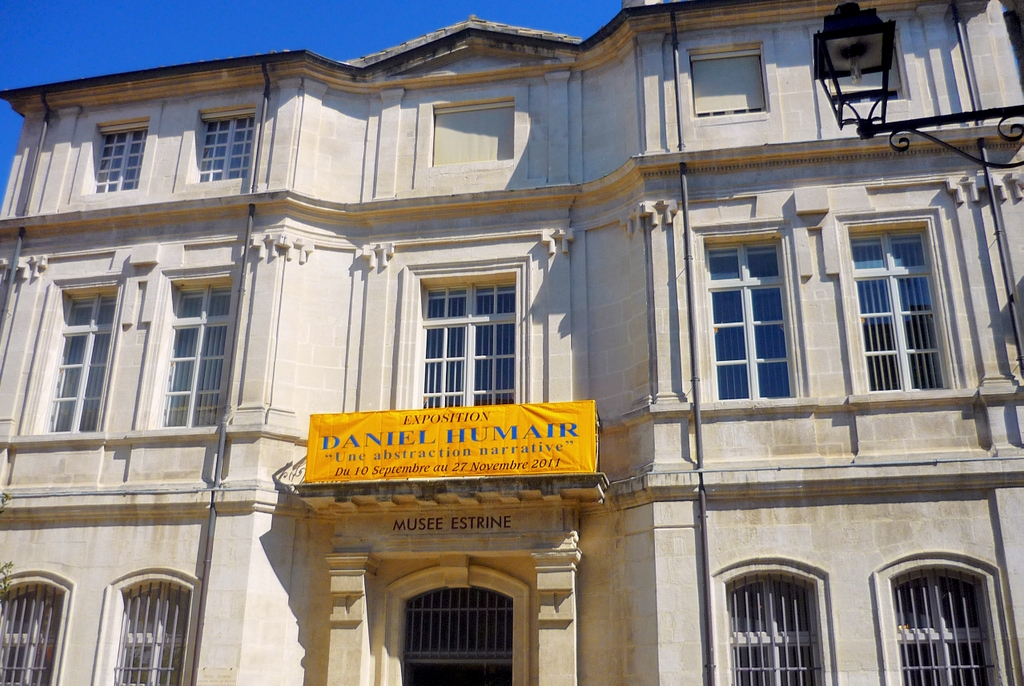
The Hôtel Estrine (Rue Estrine) dates back to 1748 and is the work of Joseph de Pistoye.
The edifice is an excellent example of Provençal 18th-century architecture.
In 1794, Louis Estrine acquired the house. This prosperous merchant from Marseilles gave his name to the mansion.
After being bought by the municipality in 1985, the townhouse was restored in 1989 to house a museum dedicated to Van Gogh: the “Centre d’Art-Présence-Van Gogh”.
Full-sized reproductions of Vincent Van Gogh’s paintings are on display, as well as some contemporary art.
Every year, the museum presents a different aspect of Van Gogh’s work and audio-visual presentations of the Dutch painter and his life and work.
Turn right and walk to the Rue Lafayette.
5. Renaissance House
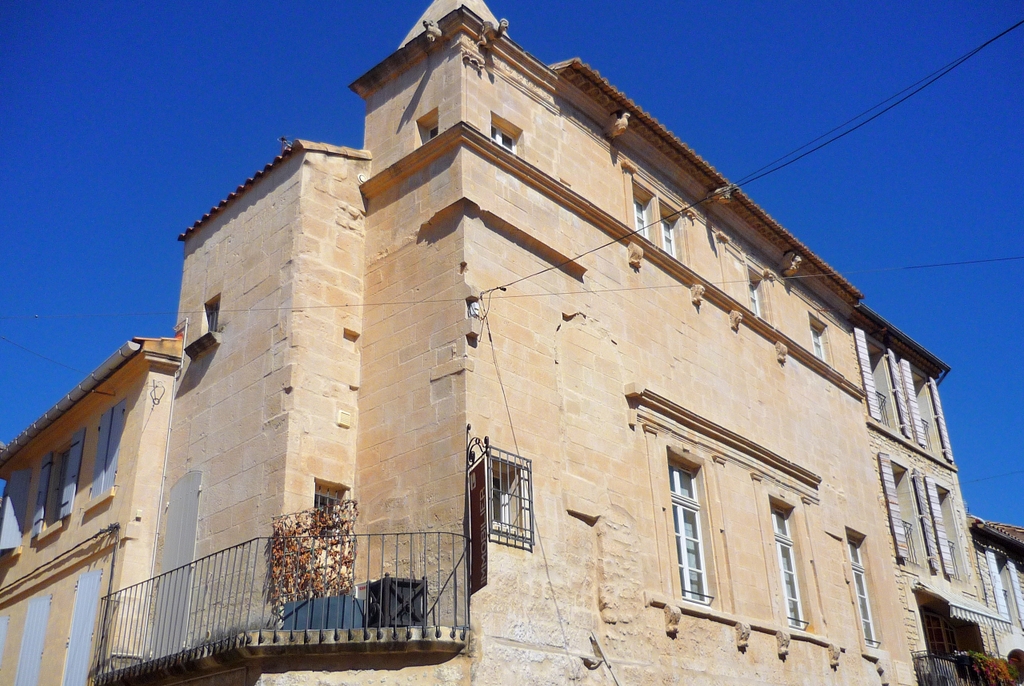
There is a beautiful townhouse from the Renaissance at the corner of Rue Lafayette and Rue Lucien Estrine. The building served as a town hall from 1806 to 1820.
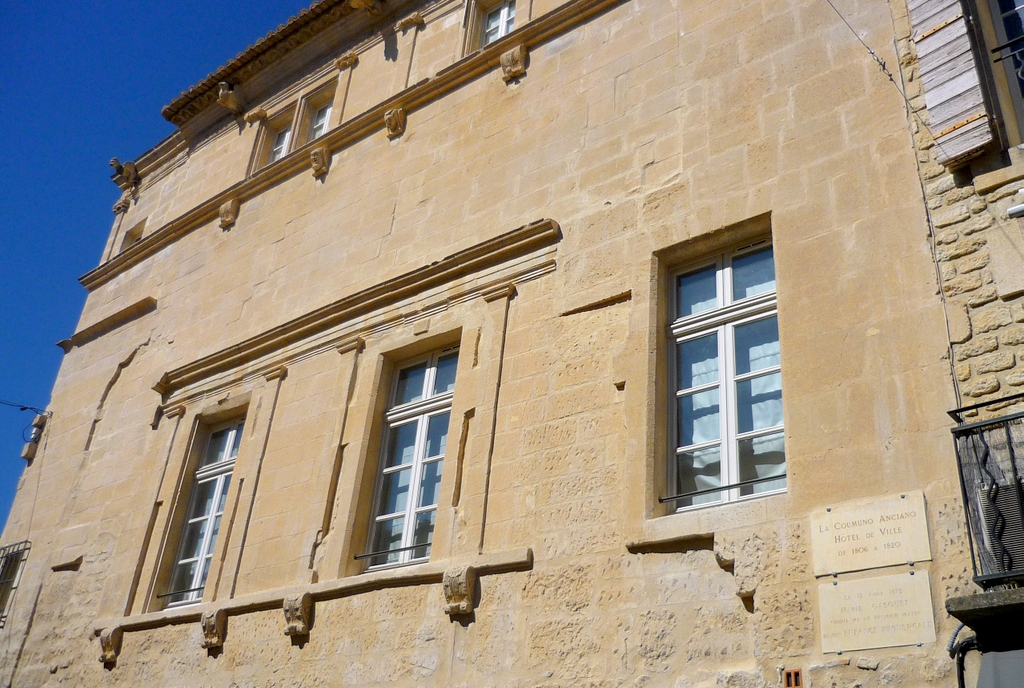
Notice the gargoyles at the top of the house!
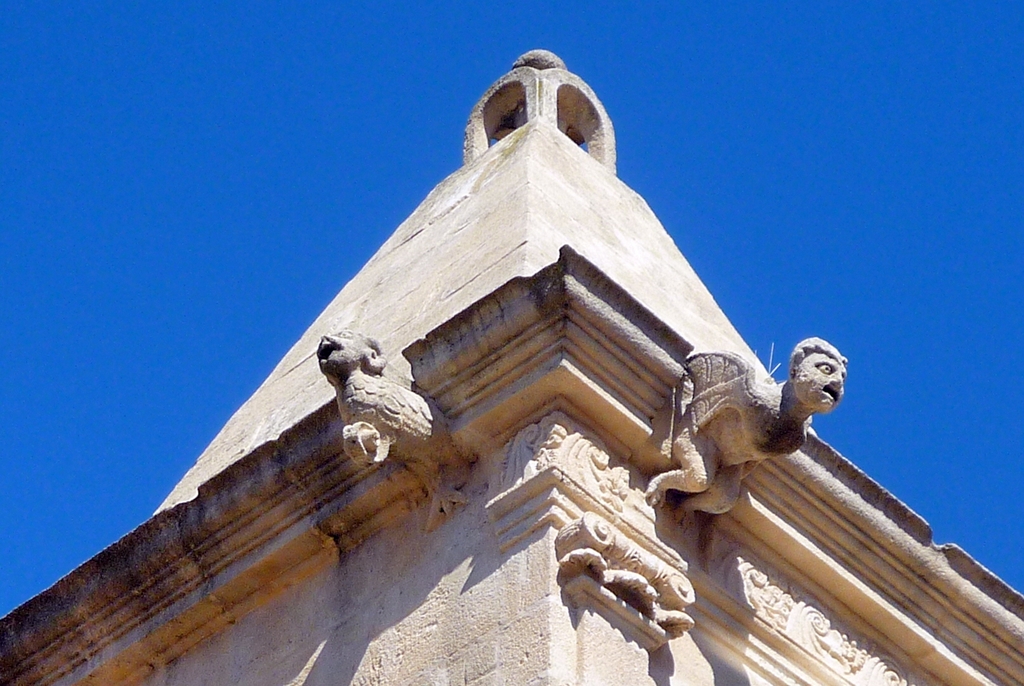
Turn left and walk on rue Lafayette towards the boulevard Mirabeau.

You are now walking on the ring road that encircles the old town. The road follows the outlines of the medieval wall. Many cafés and restaurants now border it.
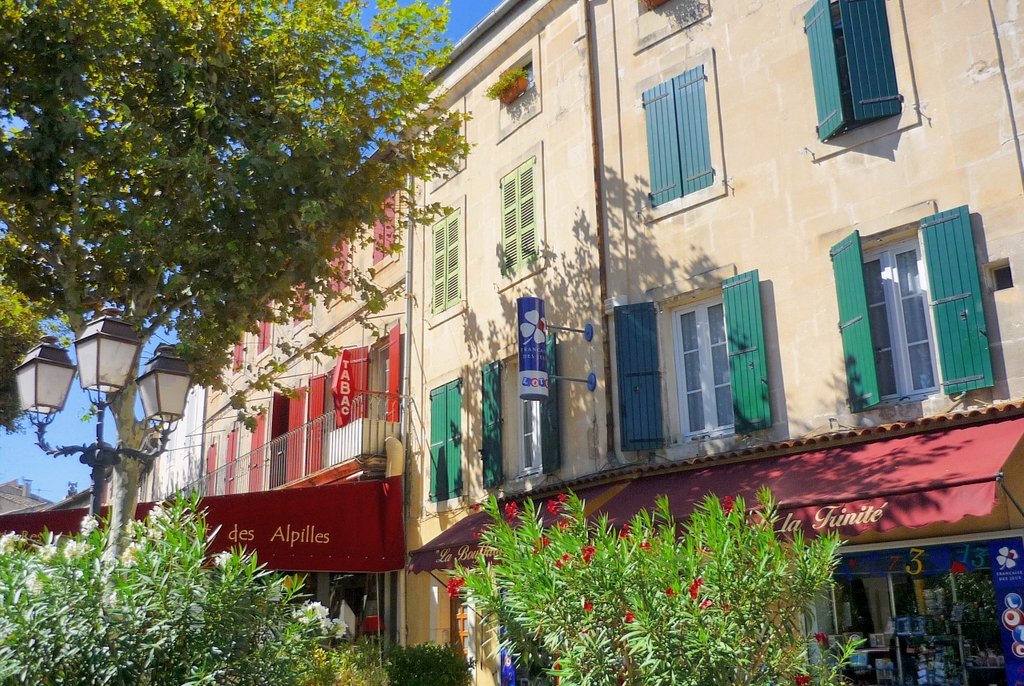
6. The Trinity Fountain
At the intersection of Boulevard Mirabeau, avenue de la Libération, and Rue Carnot stands the Trinity Fountain (Fontaine de la Trinité).
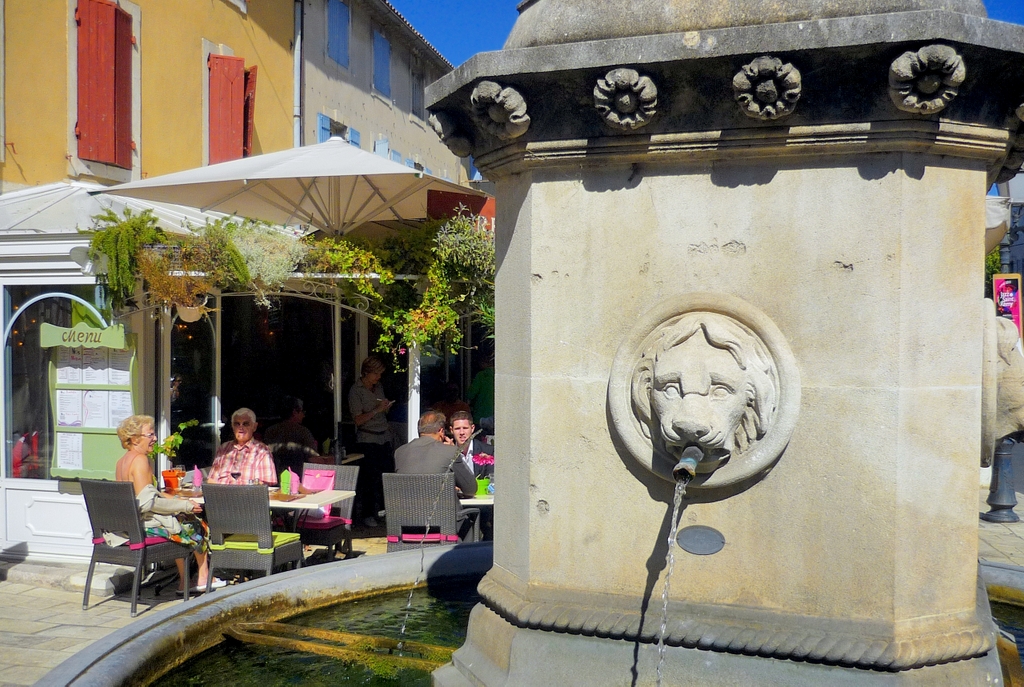
It was placed there in 1860 and destroyed in 1938 to enlarge the boulevard. Local people called for its replacement, which occurred in 2003.
Turn left onto Rue Carnot and stop at the intersection with Rue Nostradamus.
7. The Nostradamus fountain
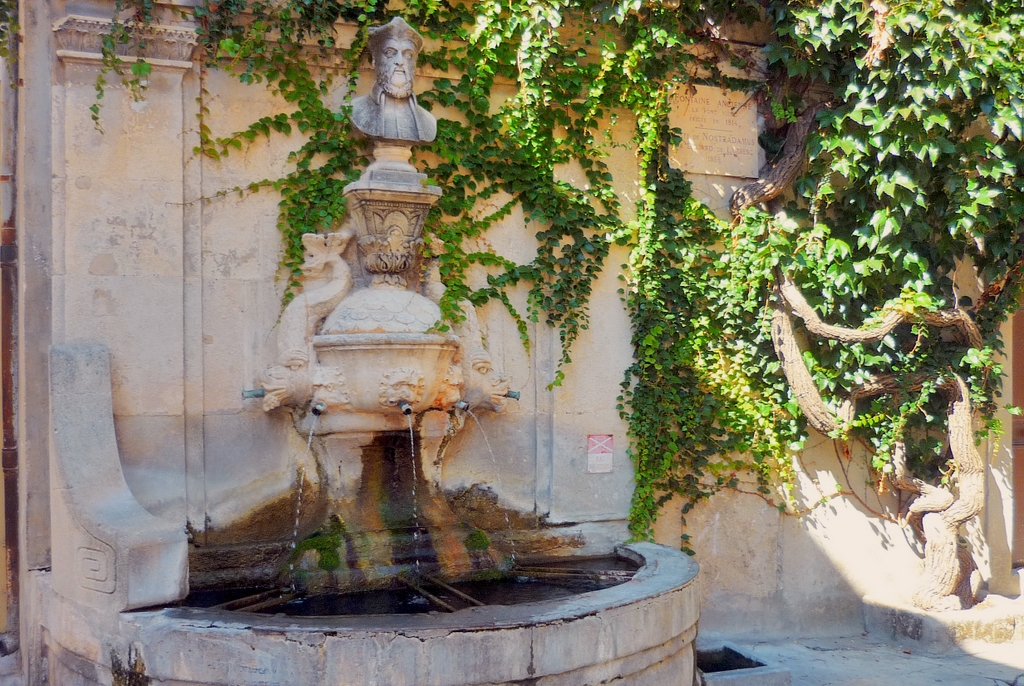
A fountain dedicated to Nostradamus decorates the corner of Rue Carnot and Rue Nostradamus.
Michel de Nostredame (born in Saint-Rémy-de-P. 1503-1566), aka Nostradamus, was a French astrologer, physician and reputed seer who is best known for his book Les Prophéties (first published in 1555).
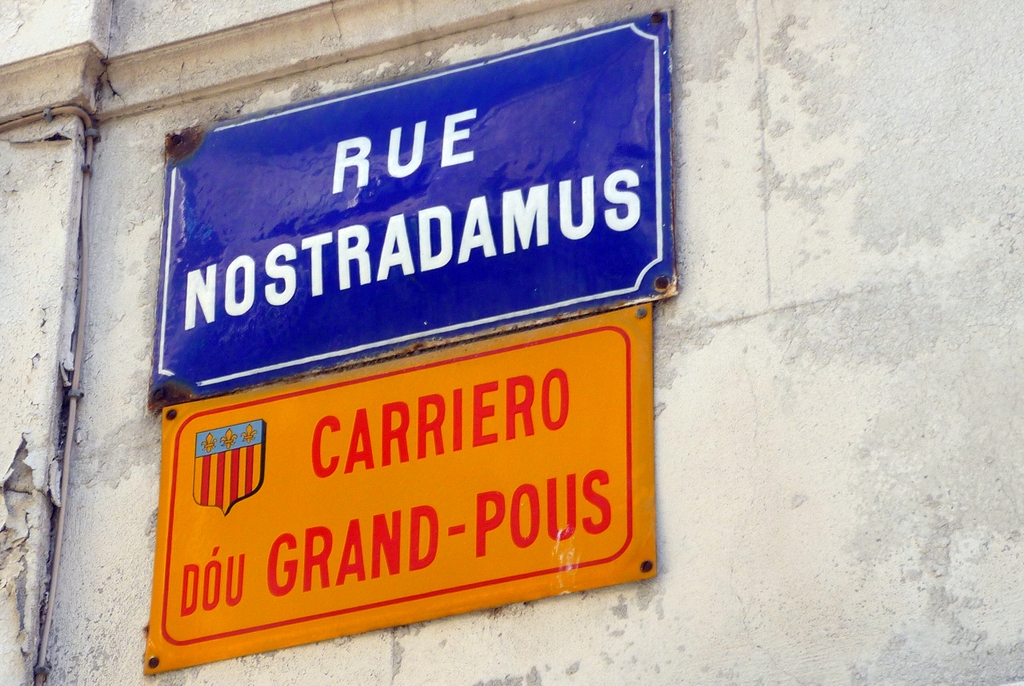
Ambroise Liotard sculpted the bust of Nostradamus, which replaced Louis XVI in 1859.
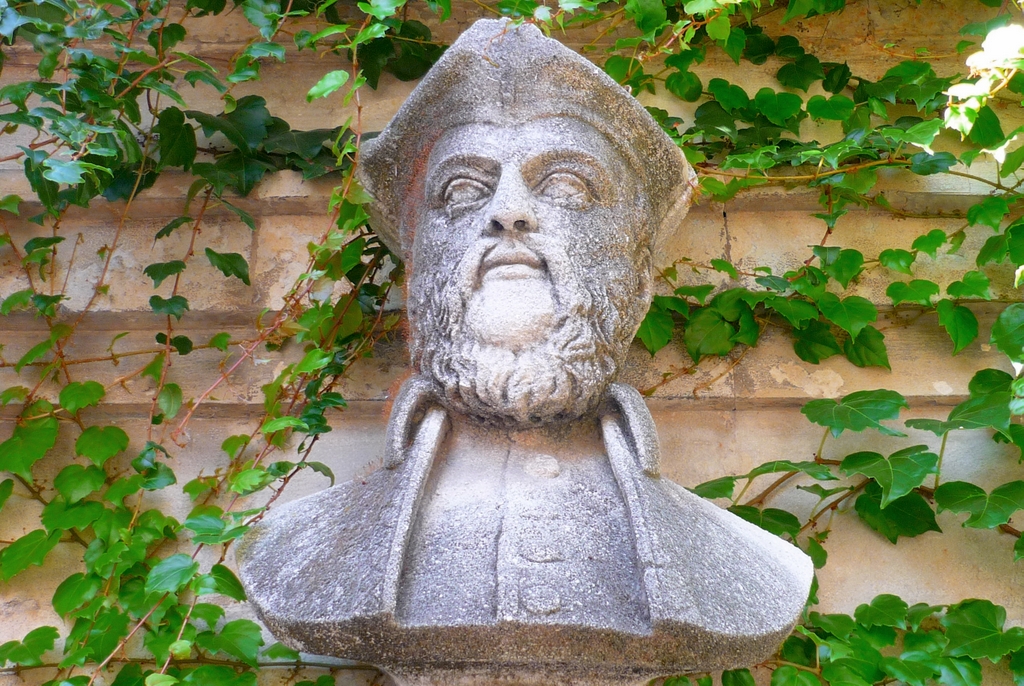
At the corner of rue Carnot and rue Nostradamus, notice the fine niche that holds a Madonna.

Continue onto rue Carnot until you reach the charming Place Favier.
8. Place Favier and Saint-Rémy’s townhouses
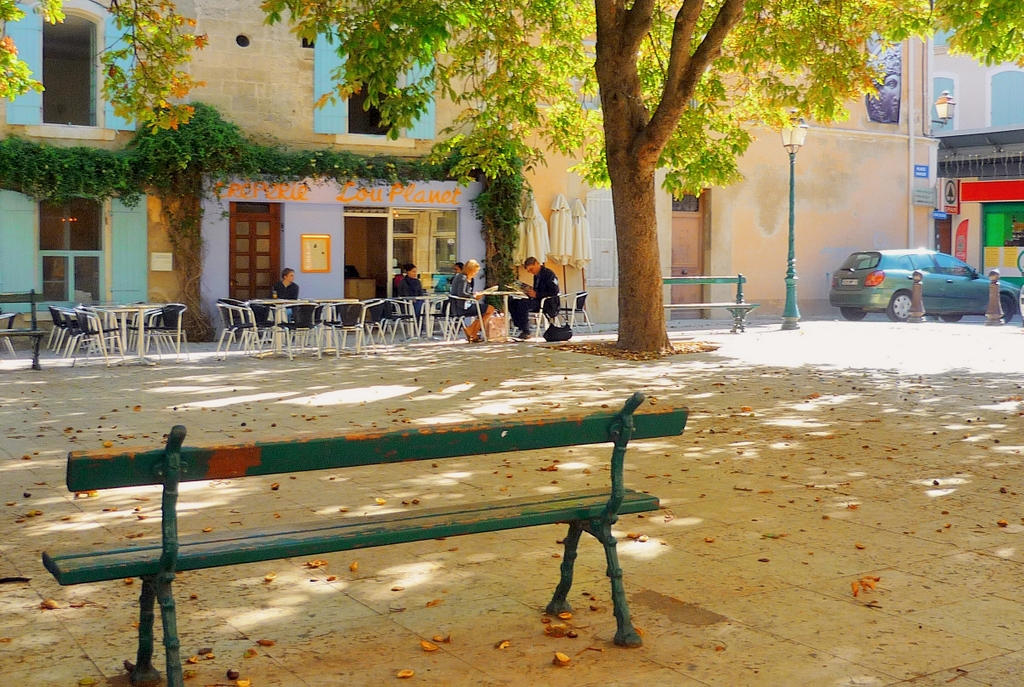
The square lies in the Planet district. Planet is a Provençal word meaning little square. It is indeed a tiny square formerly known as “Place aux Herbes” (herbs market square). It took its current name in 1849 from Doctor Favier (1773-1862), a benefactor of the poor.
There are a few beautiful hôtels particuliers (townhouses) worth seeing in Saint-Rémy: the Hôtel de Sade, the Hôtel Mistral de Mondragon, the Hôtel de Lubières and the Hôtel Estrine.
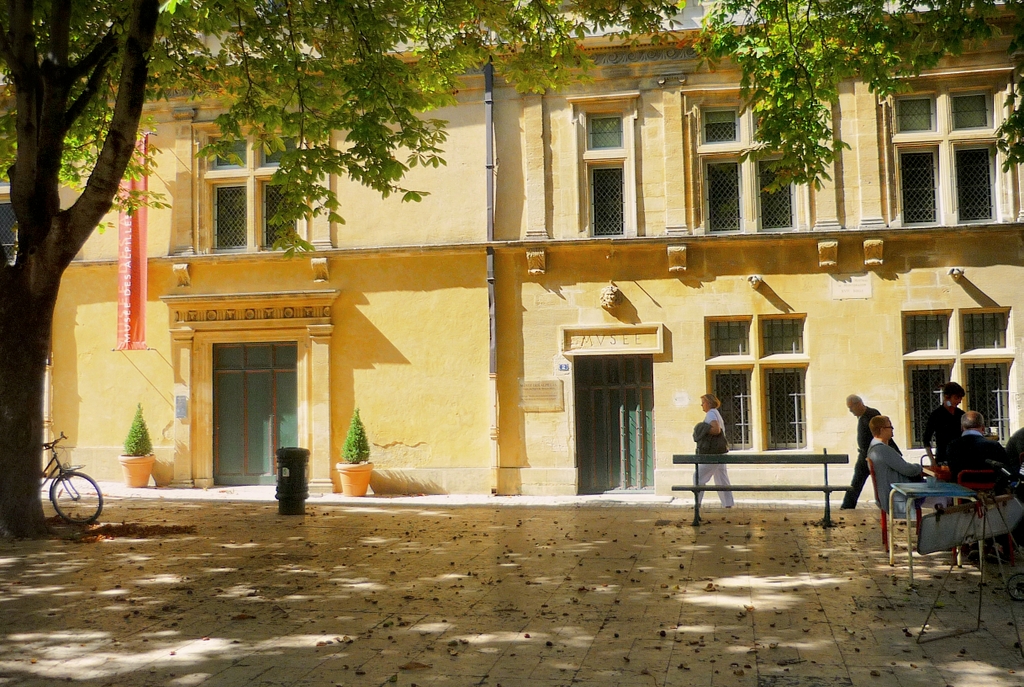
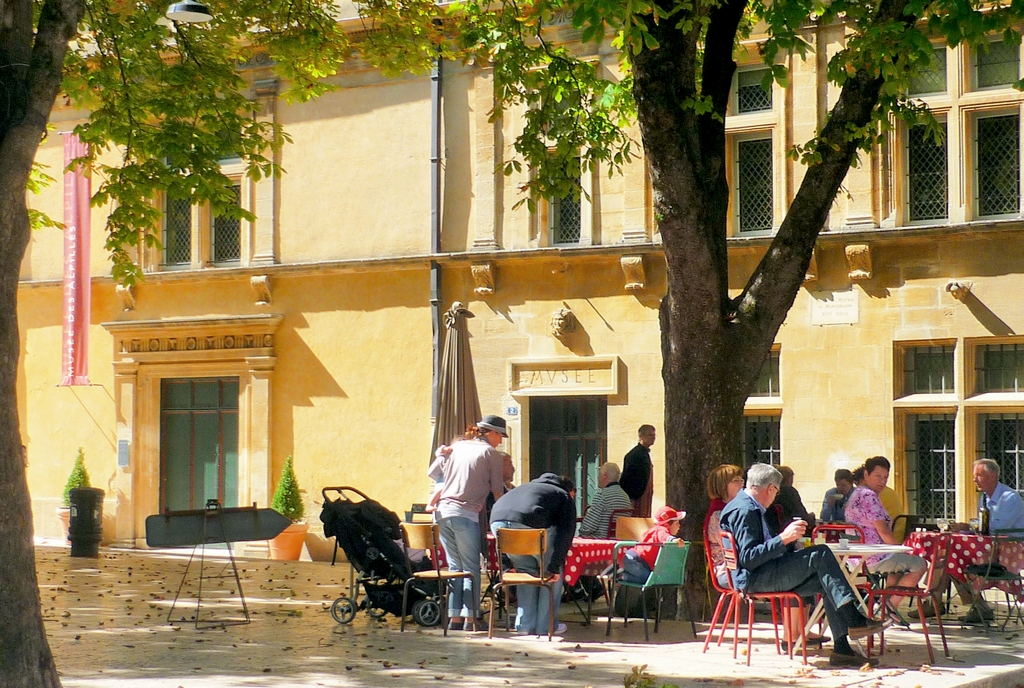
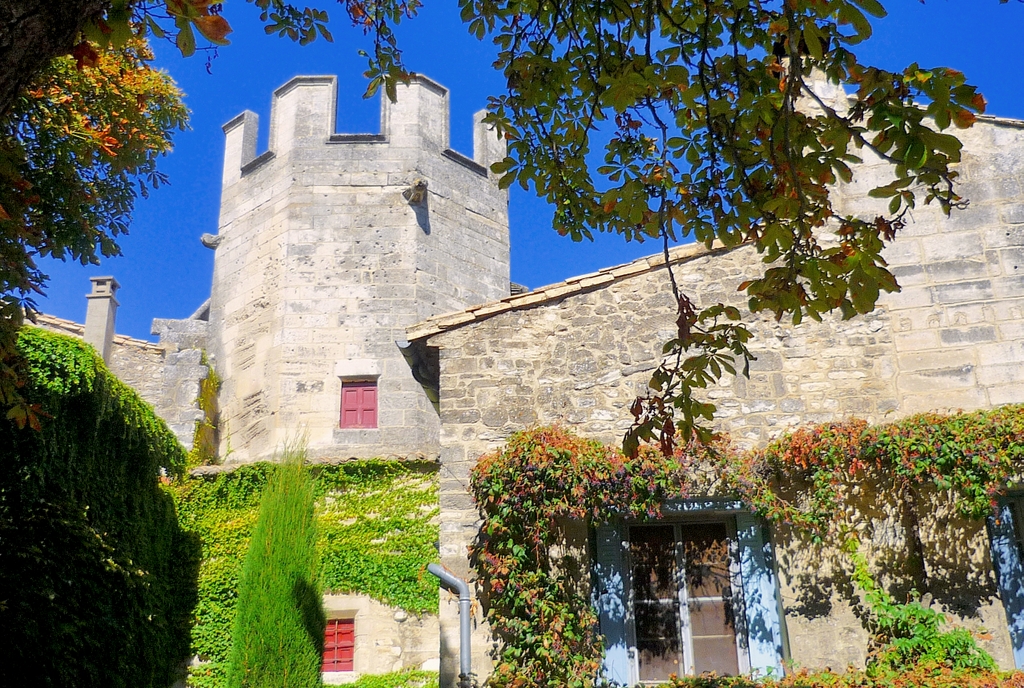
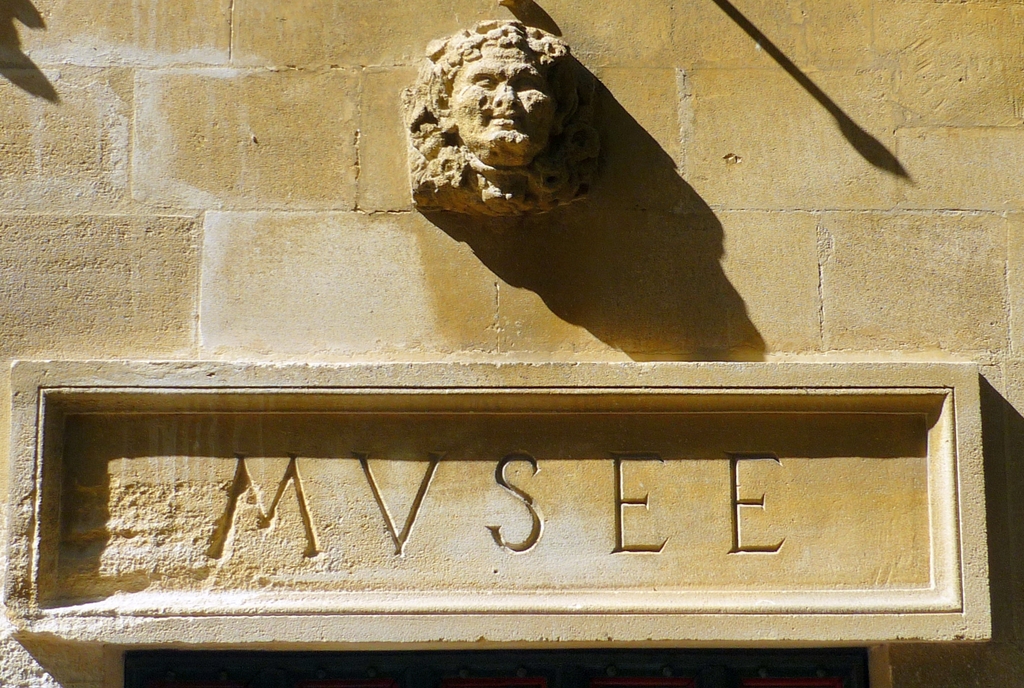
A few can be found bordering the delightful Place Favier, with peaceful cafés. A crenellated round tower adds to the charm of the square. So picturesque.
The Hôtel de Sade
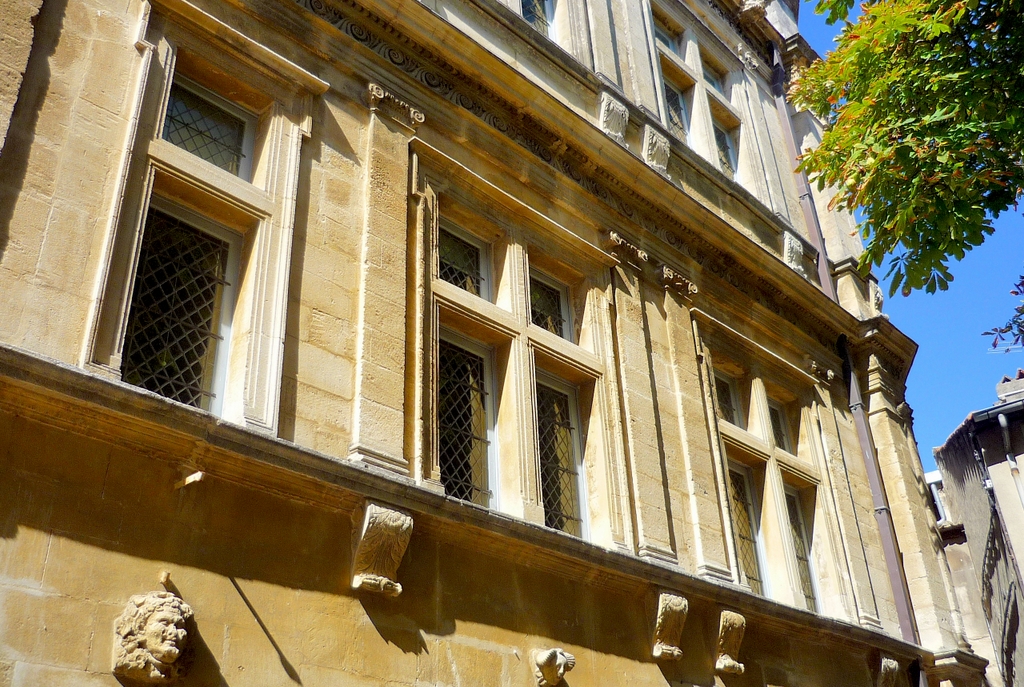
The Hôtel de Sade is situated on Place Favier and houses an archaeological museum devoted to the nearby Roman ruins of Glanum.
Before serving as the town’s parish church, the townhouse was a priory. Later, it stored the cereal crops for the bishop of Avignon.
Hélène Hugolin de Fos commissioned the arch stretching across the street in the 15th century to connect her family residence to a new edifice.
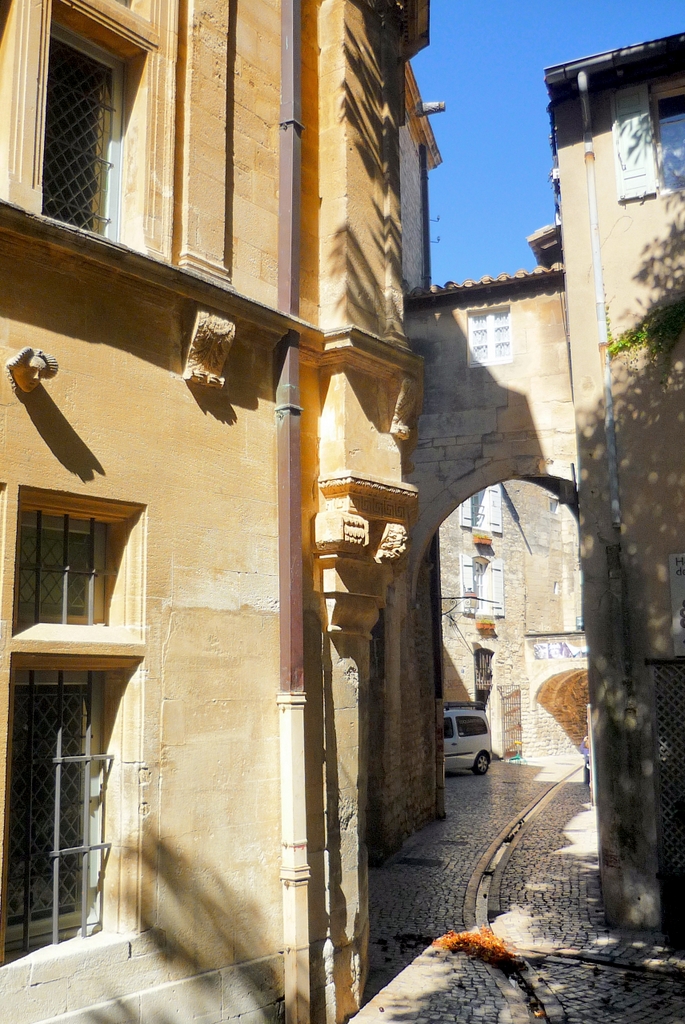
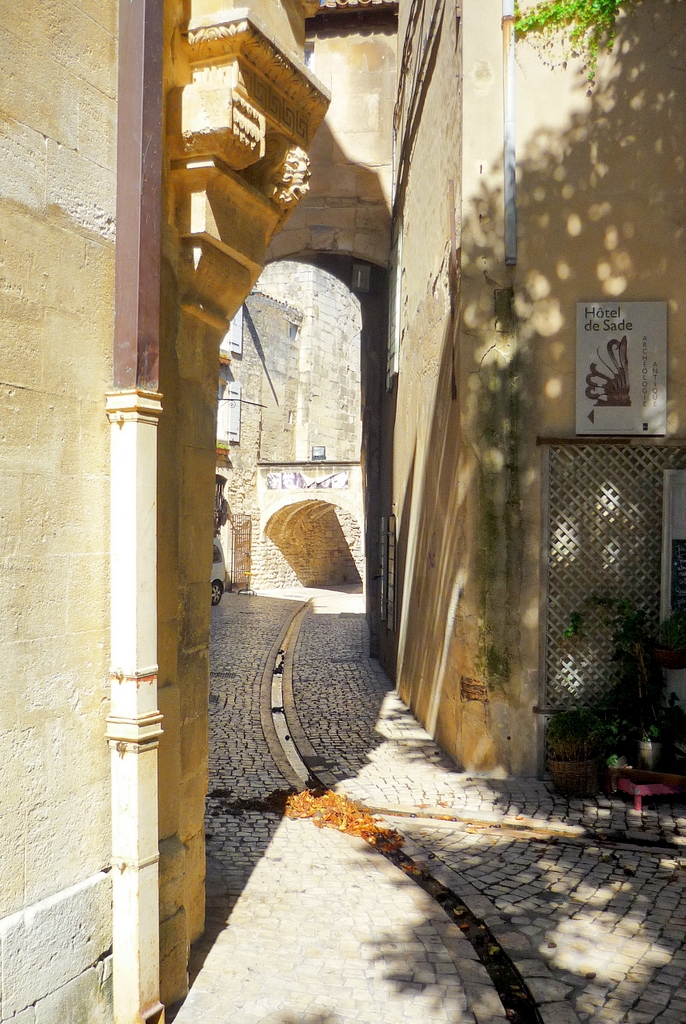
The Hôtel Mistral de Mondragon
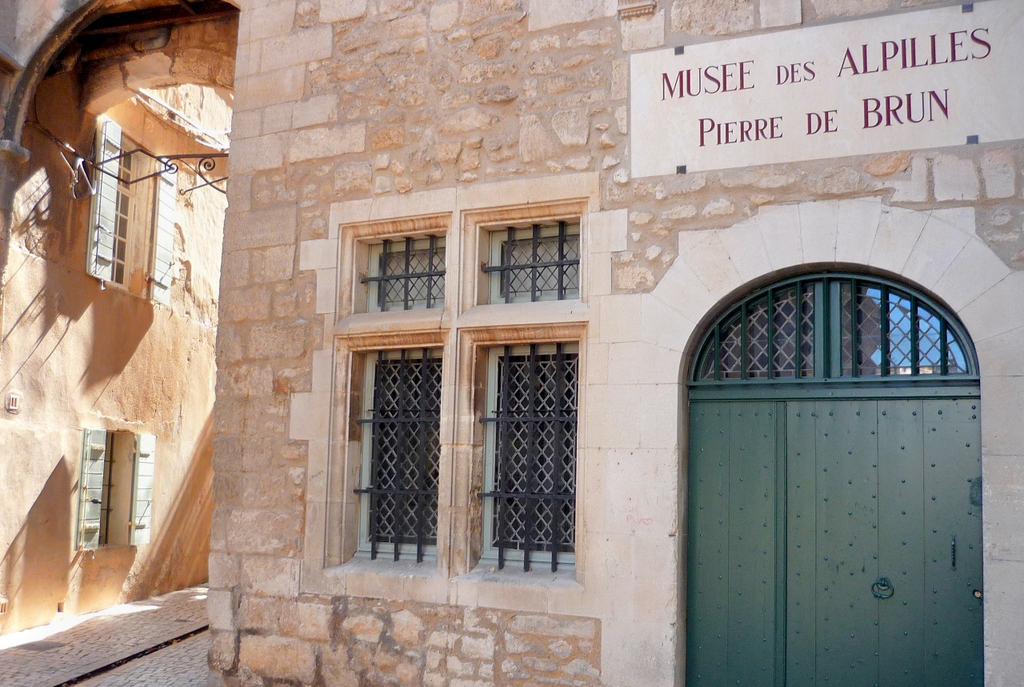
The Hôtel Mistral de Mondragon stands next to the Hôtel de Sade on Place Favier.
It is a magnificent Renaissance townhouse from the 16th century, richly decorated with sculptures and a staircase tower overlooking a beautiful central courtyard.
The townhouse takes its name from the Mistral de Mondragon family, who built it, and it changed hands several times until the municipality bought it in 1921 to house the city museum.
It currently houses the Musée des Alpilles and displays an attractive range of traditional folk art and industrial and rural items belonging to this region of Provence. The museum has recently reopened after extensive restoration works.
The Hôtel de Lubières
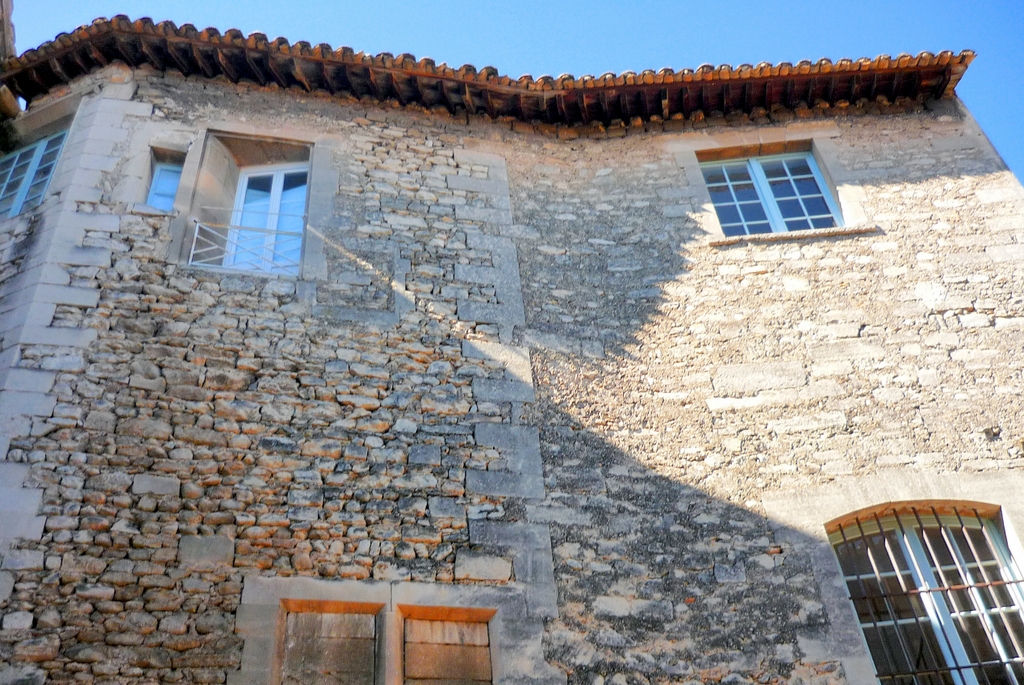
On Boulevard Marceau stands the 17th century Hôtel de Lubières.
This private townhouse – the Maison de l’Amandier – features a remarkable spiral staircase leading up to rooms with high-beamed ceilings.
The mansion is devoted to the protection and promotion of the natural plant species of the Alpilles, most notably the almond tree.
The house exhibits the works of a sculptor working with almond wood and other temporary exhibitions.
Go back to Rue Carnot and walk a distance of 100 m before reaching the Boulevard Marceau. Turn left and reach the church.
9. St. Martin Collegiate church
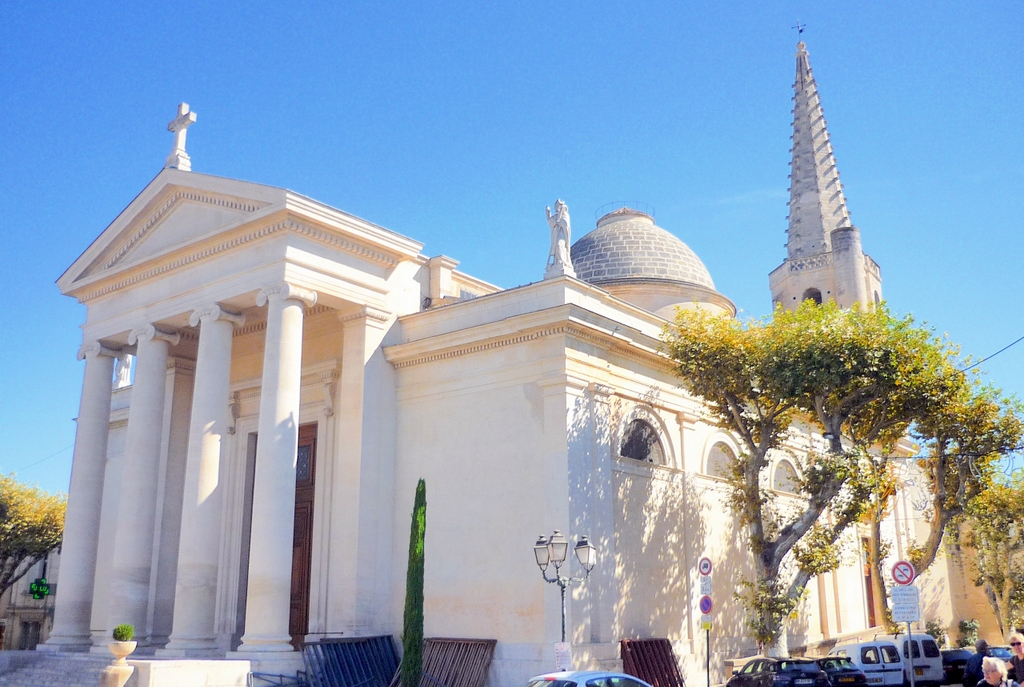
The Saint-Martin collegiate is Saint-Rémy-de-Provence’s most prominent building. You won’t miss it as the church stands in the heart of the town.
The monumental façade of the neo-classical style is a reconstruction from the 19th century following the 1818 collapse of the previous structure. Only the 14th-century Gothic belltower stood intact, with the striking Gothic chapel of Renaud d’Alleins at its foot.
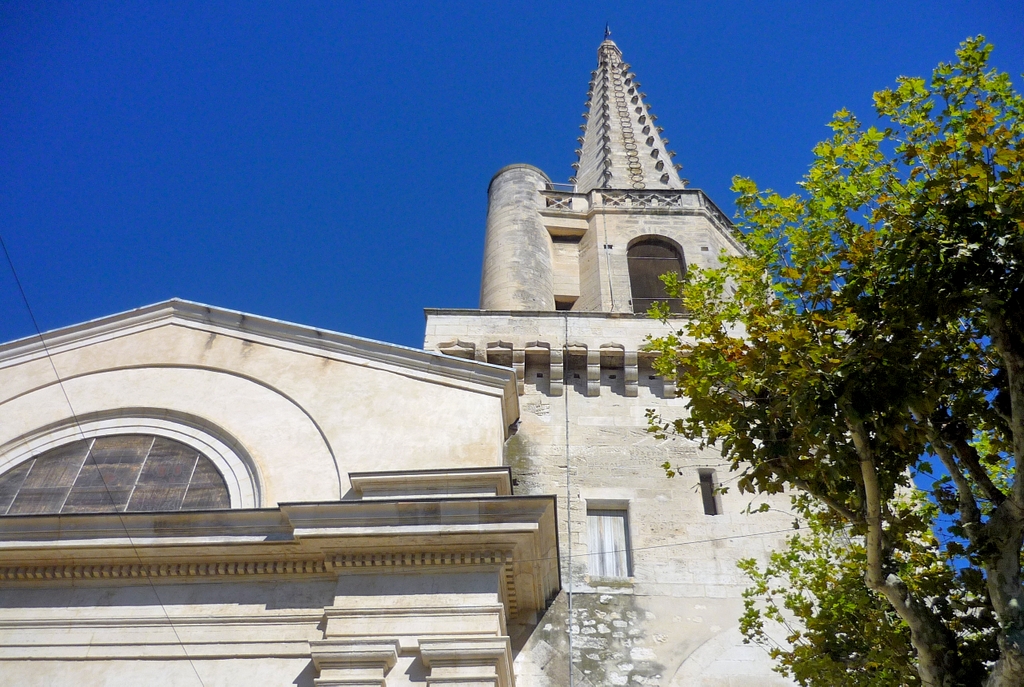
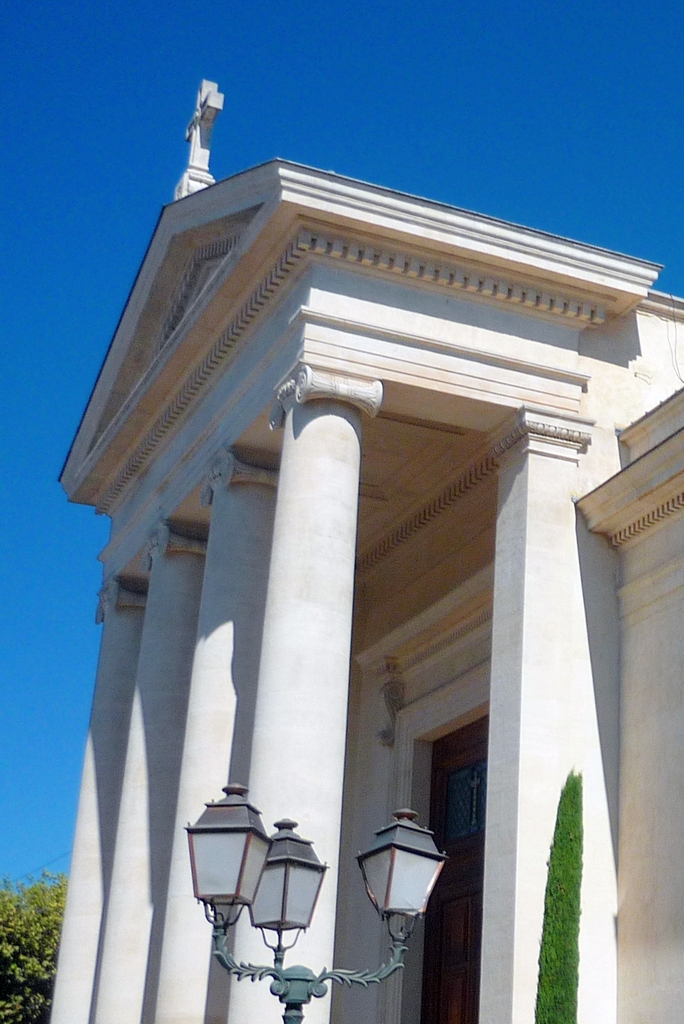
The view of the Gothic bell tower and dome of Saint-Martin against the backdrop of the Alpilles has become an iconic view.

The church is famous for its organ chest, restored in 1982 by organ maker Pascal Quoirin.
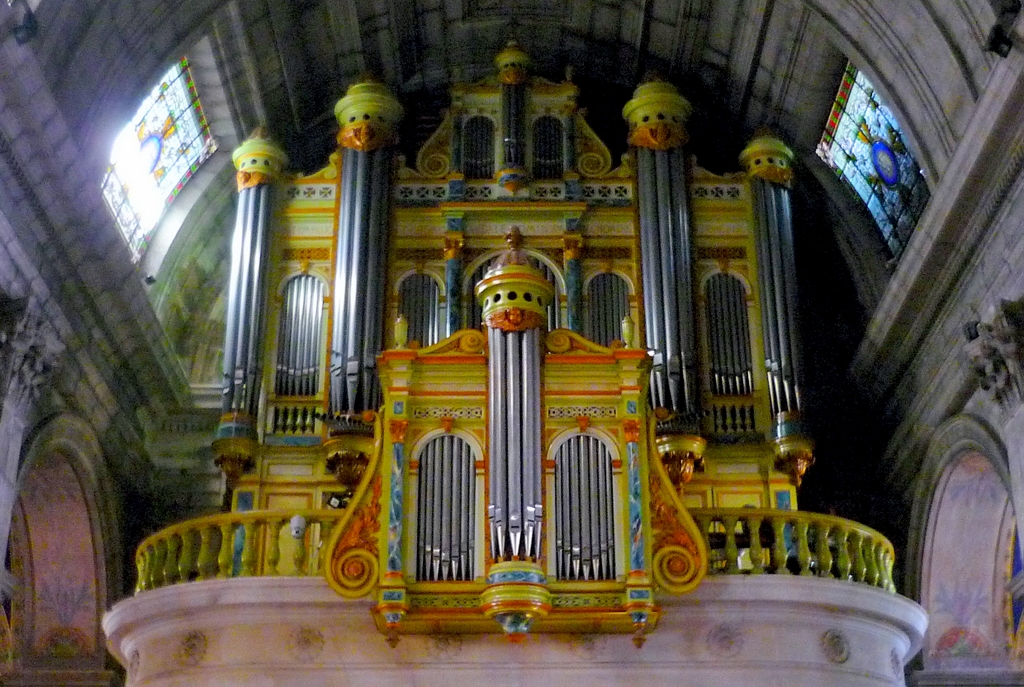
Saint-Rémy welcomes the best organ musicians in the world during the Organa Festival.
Free concerts occur inside the church at 5.30 pm every Saturday between July and September.
Take Rue de la résistance, which follows the south side of the church. Notice the old house with its turret (number 1 rue Lafayette) and turn right onto rue Hoche.
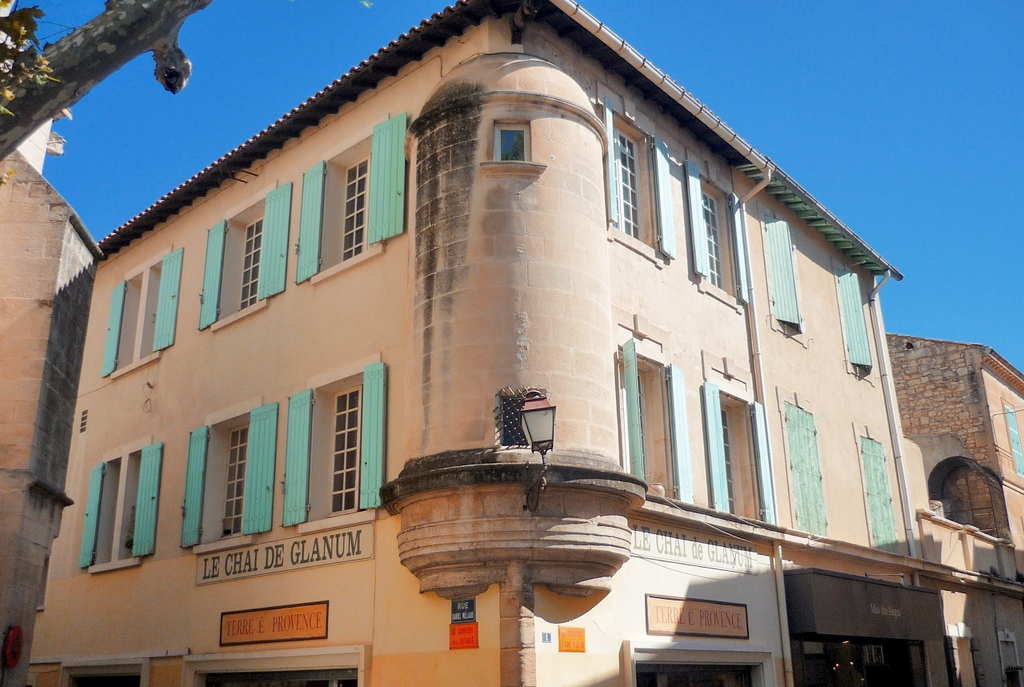
10. Rue Hoche: the birthplace of Nostradamus
Rue Hoche follows the outlines of the inner wall of the town. You can still see parts of the old wall.
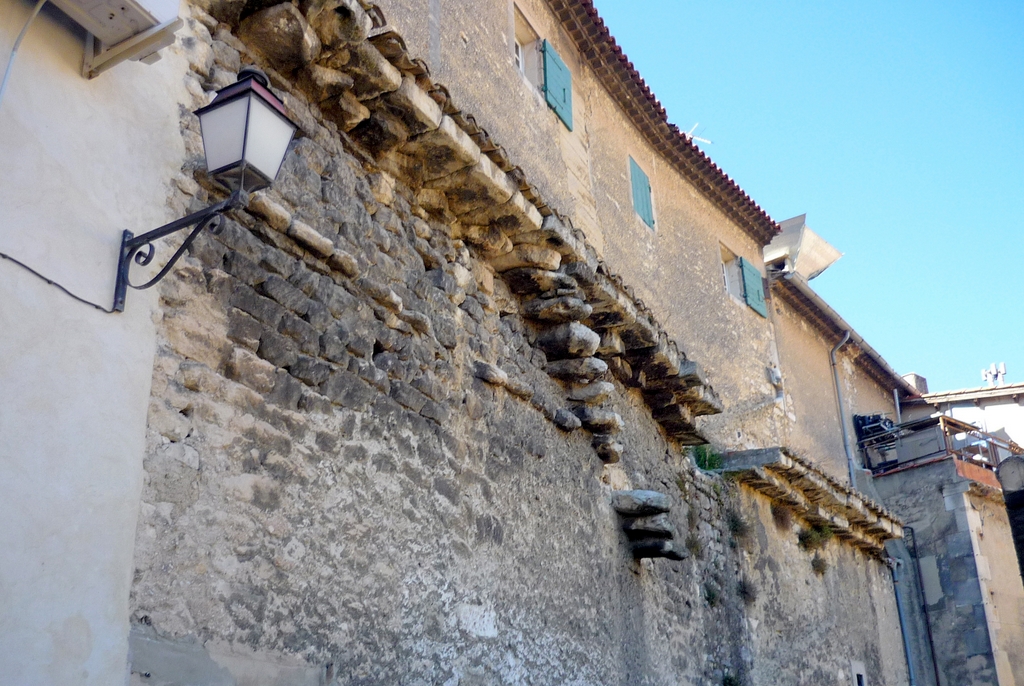
At number 6 Rue Hoche are the remains of the house where Michel de Nostredame (aka Nostradamus) was born in 1503. The 15th-century façade is contemporary to the astrologer, but the house is not open to visitors.
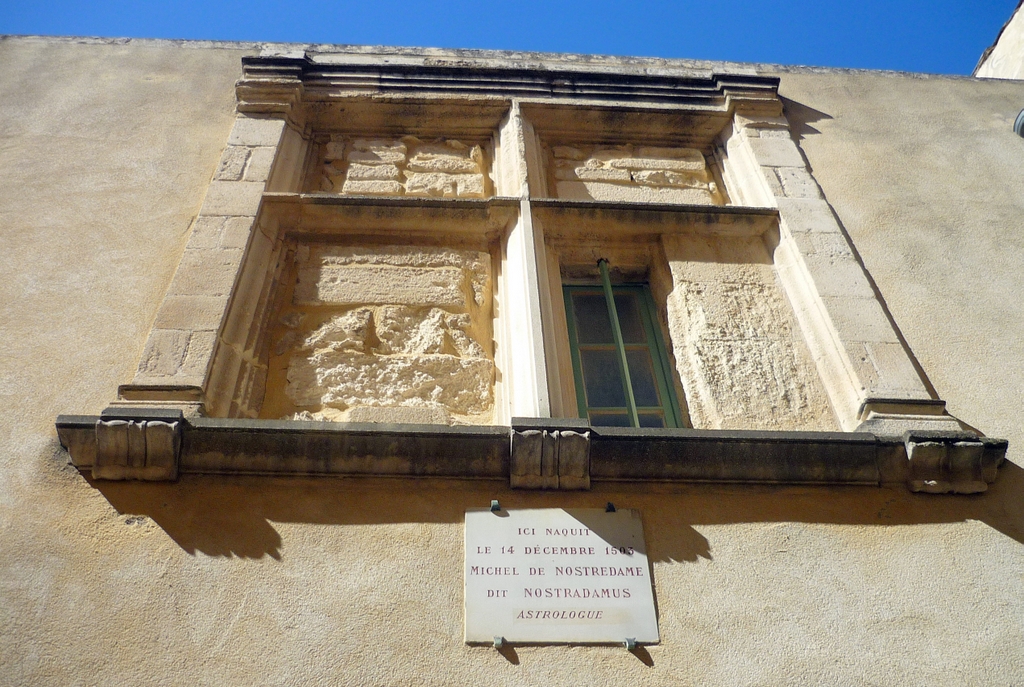
A little further away is the former St. James Hospital. The elaborate doorway still shows the characteristic shell of St. James. The hospital closed in 1653.
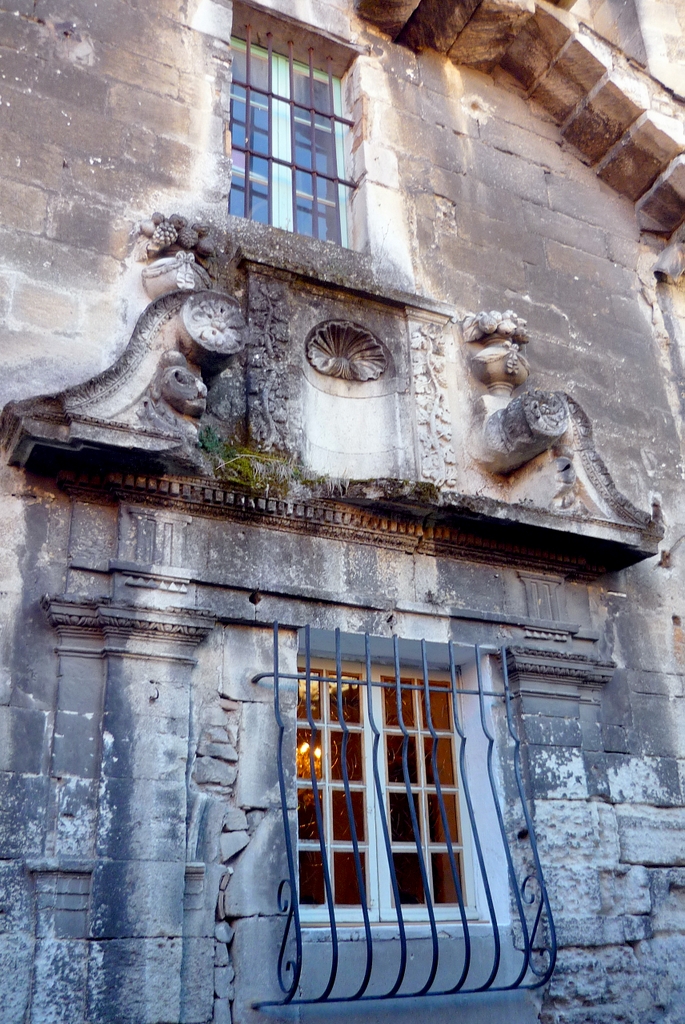
Check behind you to spot the church’s spire and dome!
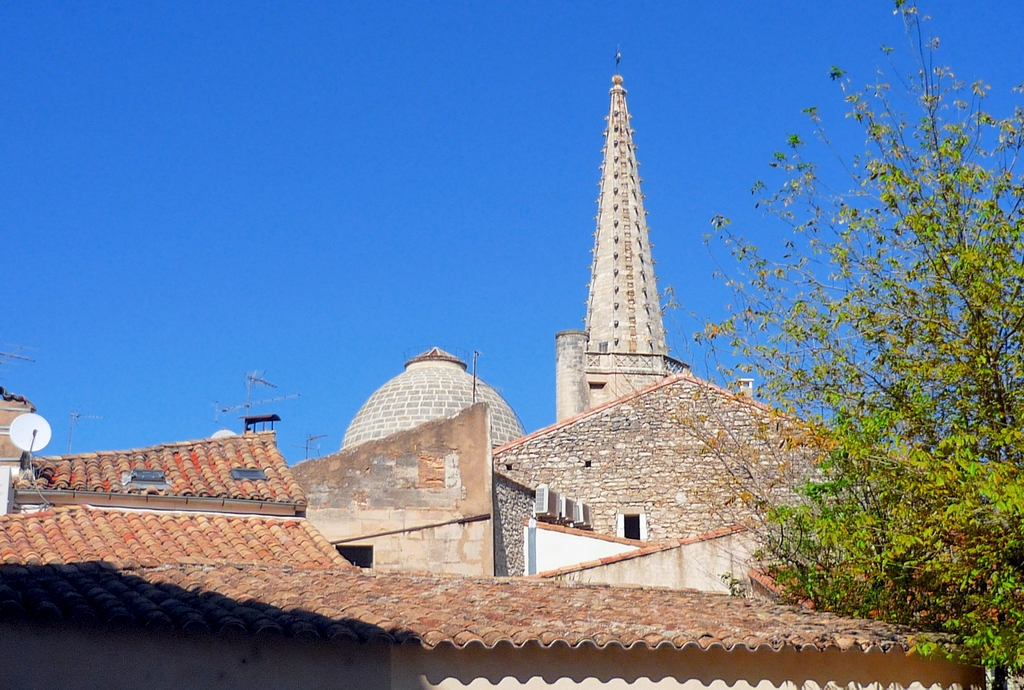
Rue Hoche leads to the intersection of Rue du 8 Mai 1945 and Boulevard Victor Hugo.

Turn left onto Boulevard Victor Hugo and then right onto Avenue Pasteur. The Tourist Office and car park are distant by 100 m.
On your visit to Saint-Rémy-de-Provence, you will discover other cobblestone lanes, secretive courtyards, colourful ochre façades of old houses and many fountains. Just open your eyes and take time to feel the soft Provençal atmosphere…
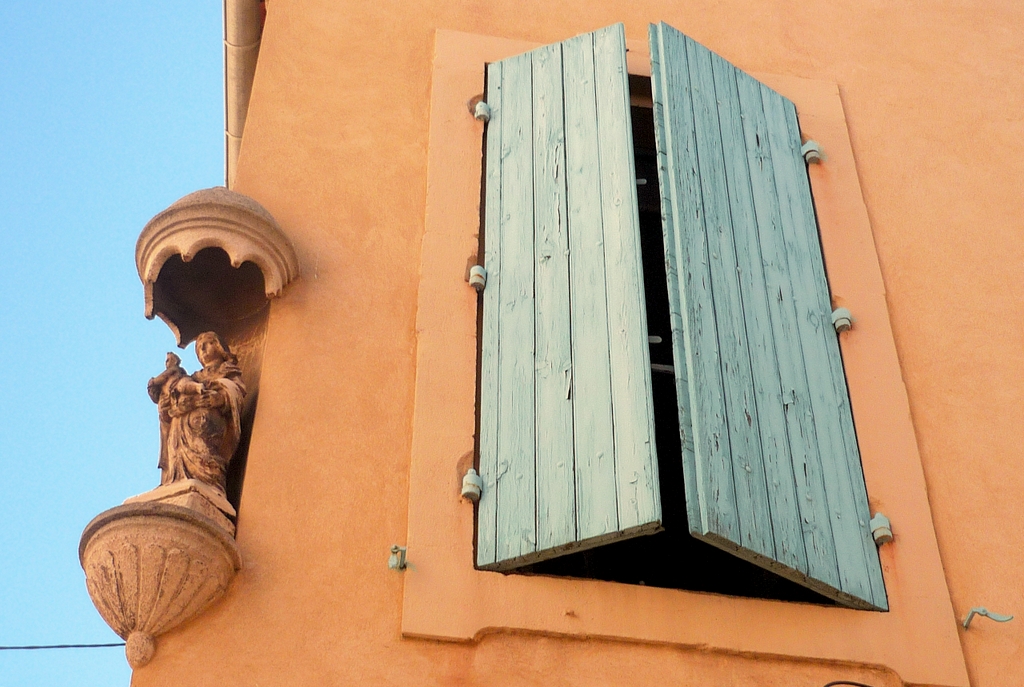

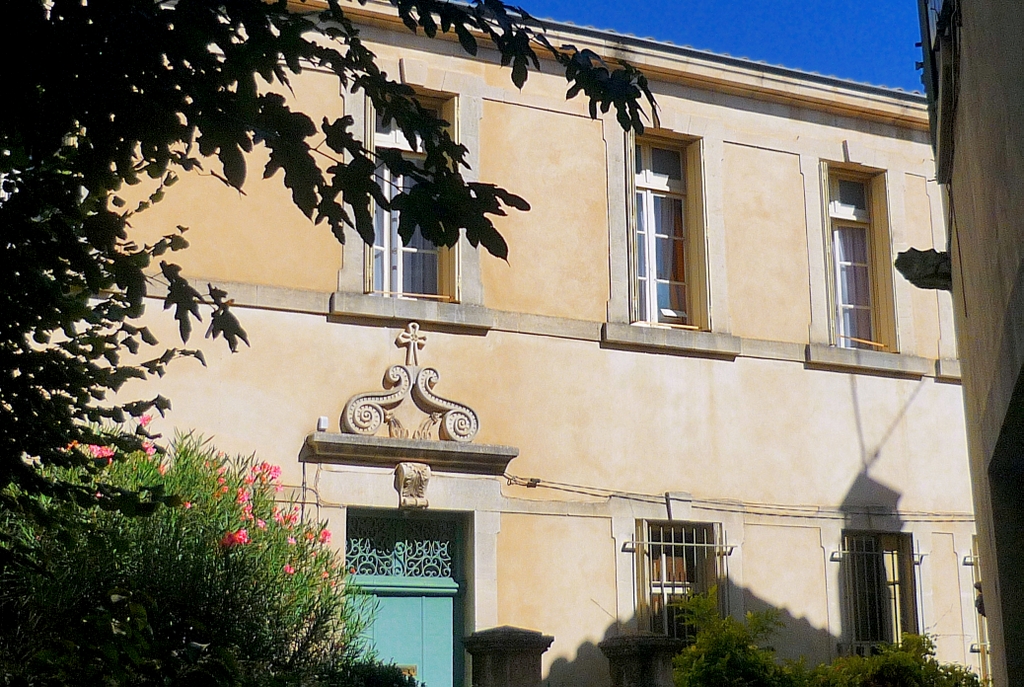
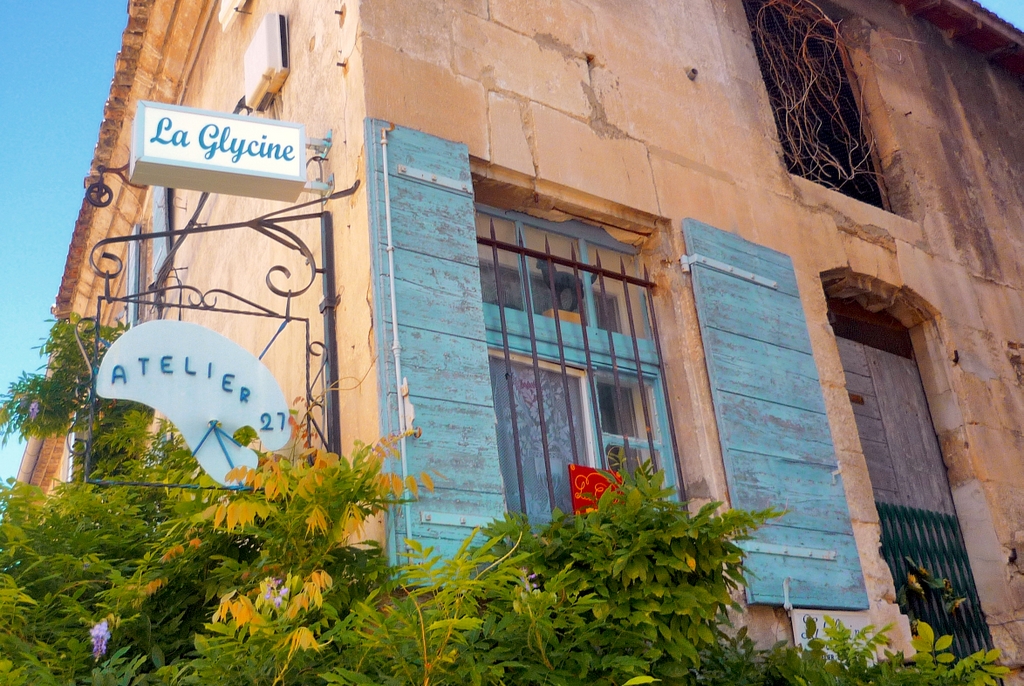
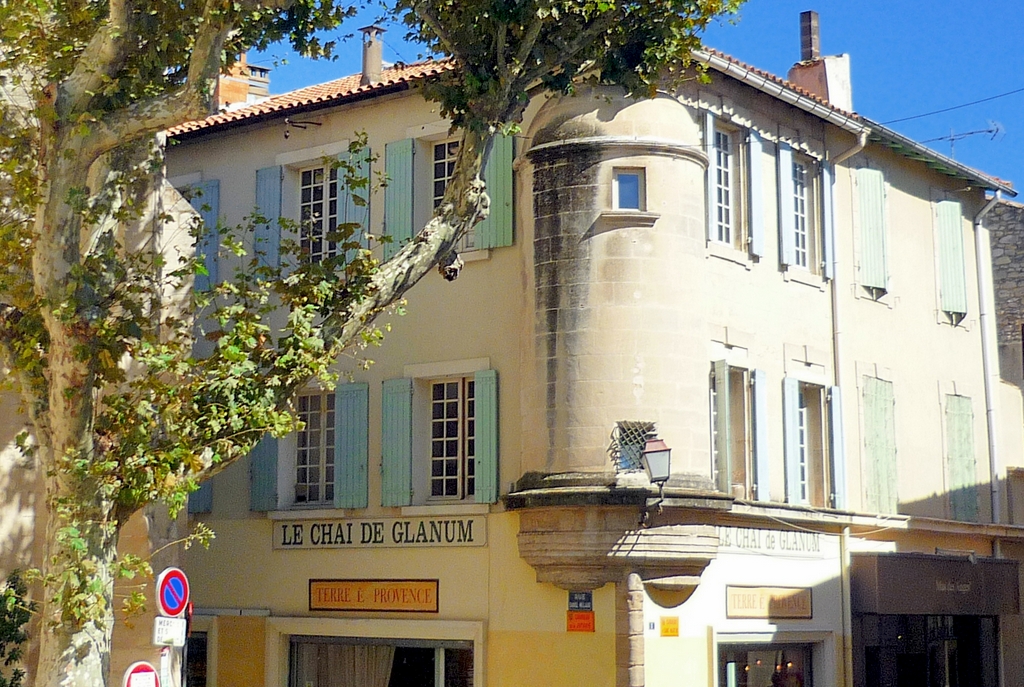
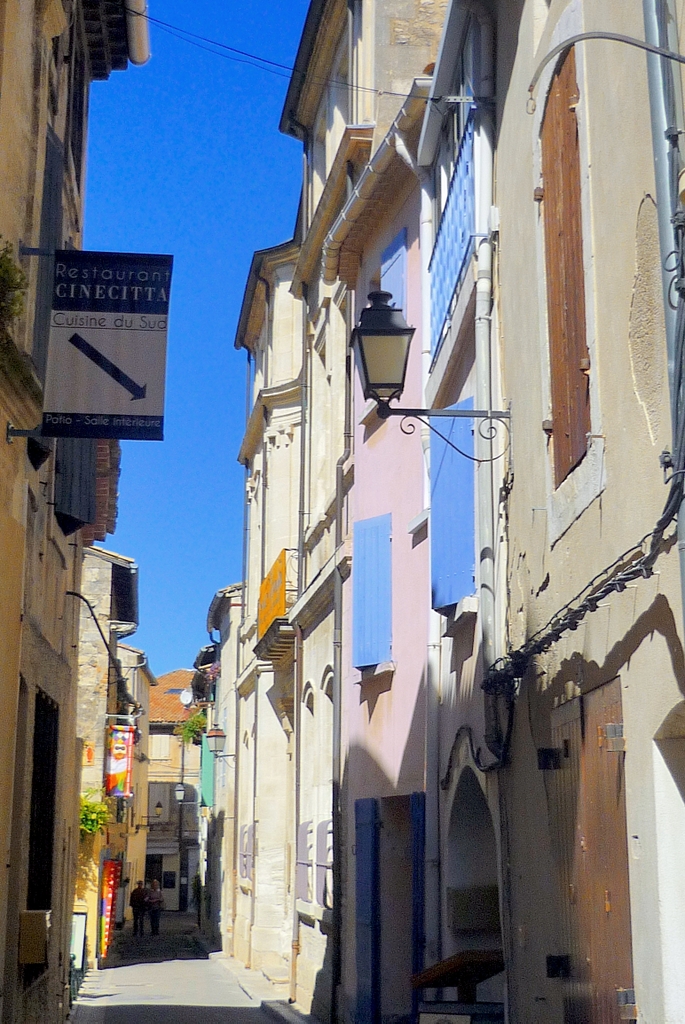
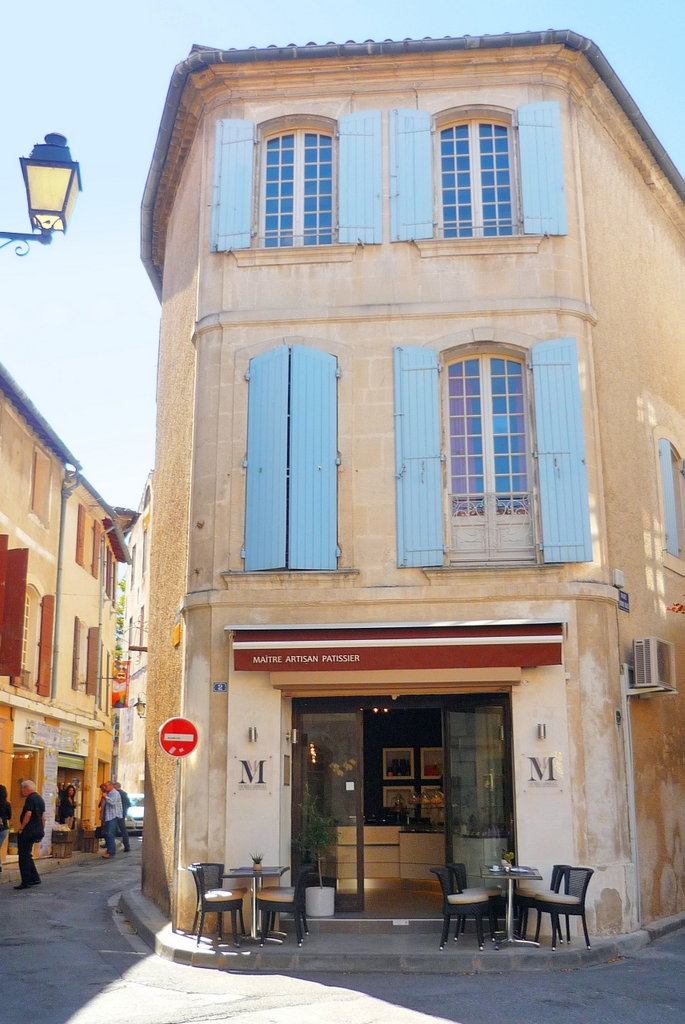
The shadow of Van Gogh in Saint-Rémy-de-Provence
Vincent Van Gogh spent only one year in Saint-Rémy-de-Provence, from May 1889 to May 1890. Coming from Arles, he requested to be put into medical care in the Saint Paul de Mausole hospital, 1km south of the town.
The quality of light and the beauty of the local landscapes greatly inspired the painter, who completed more than 150 paintings and numerous sketches during his time there.
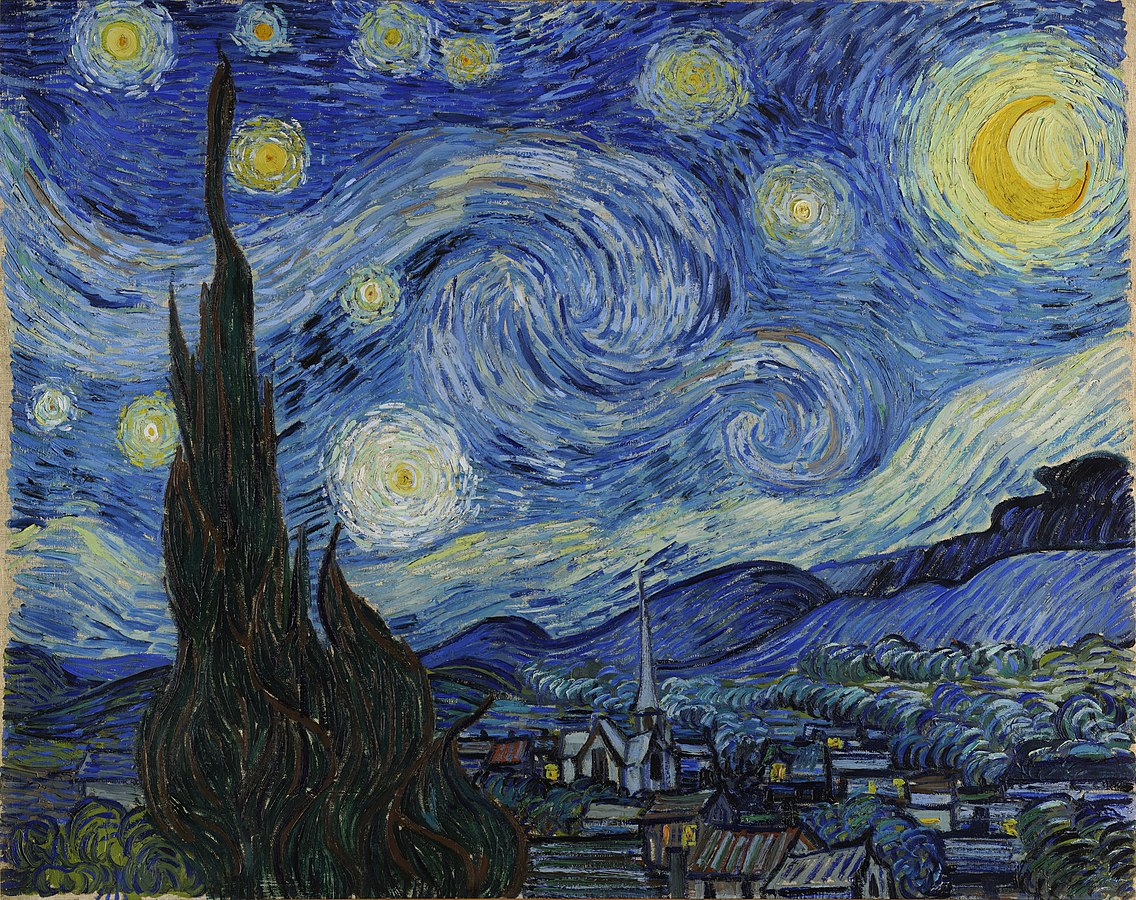
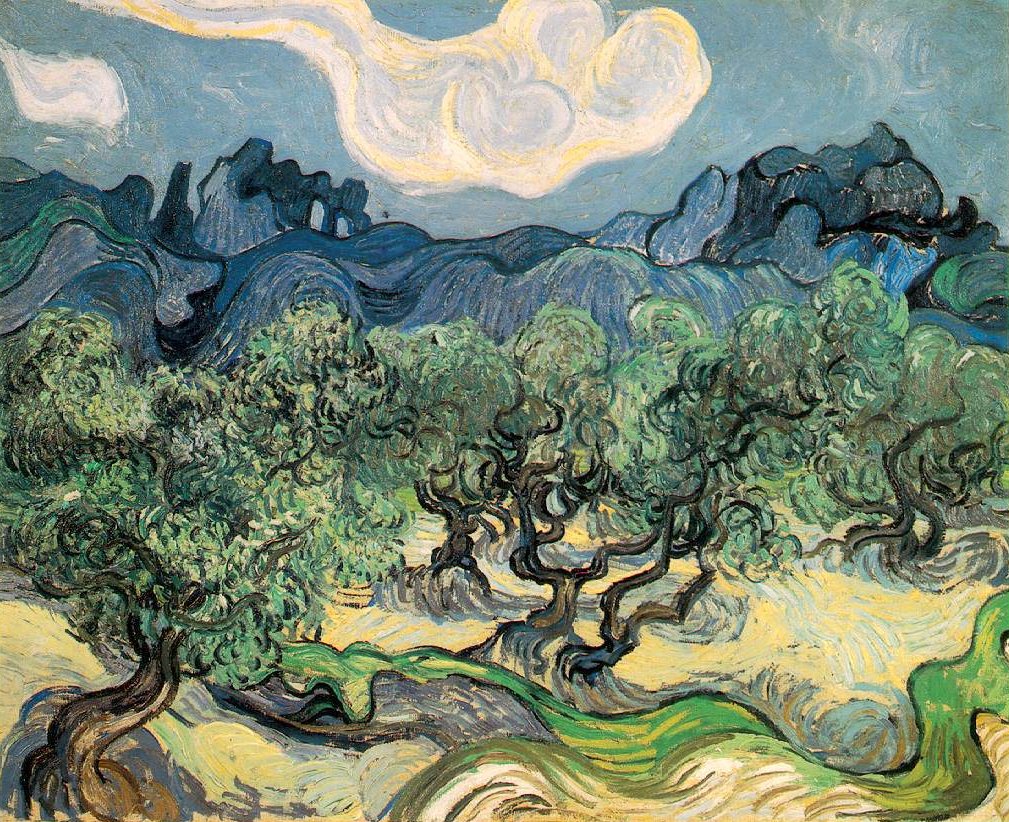
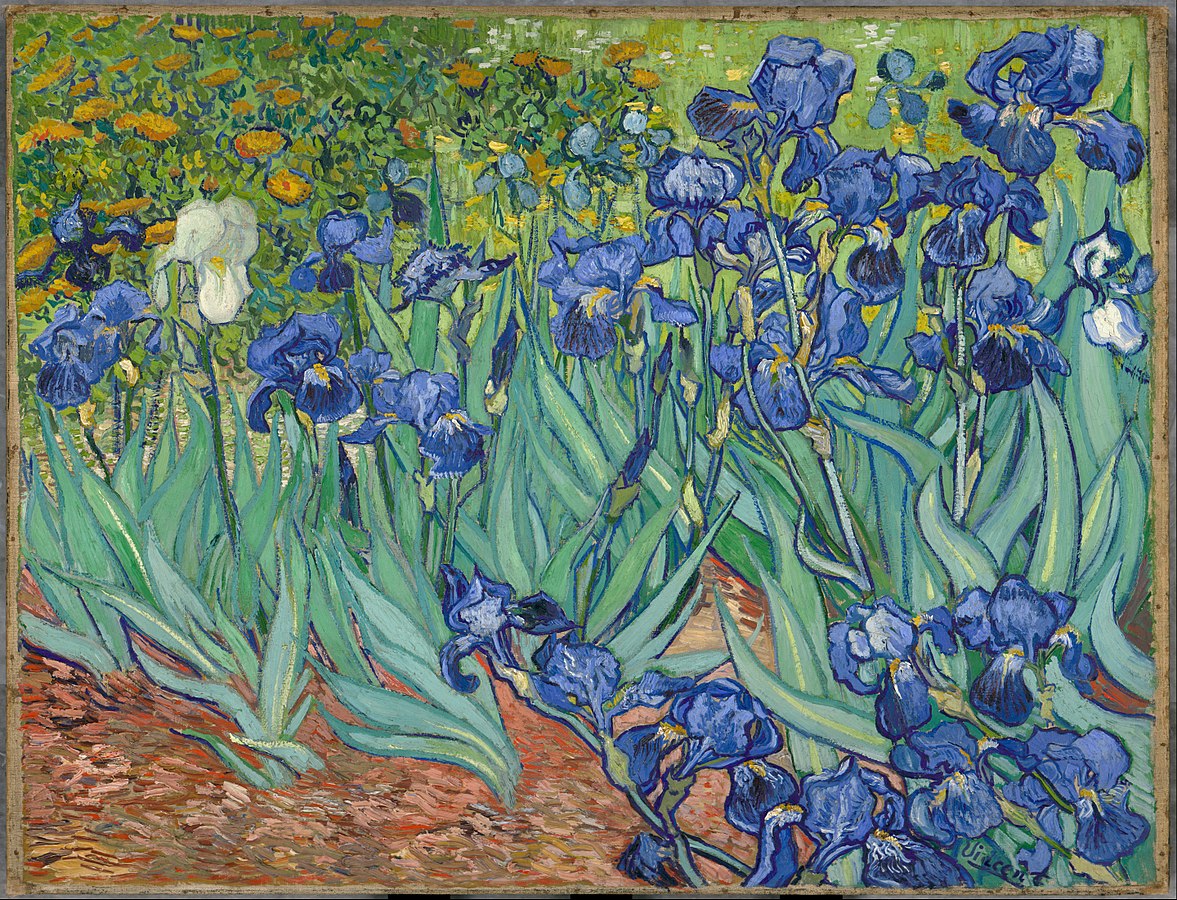
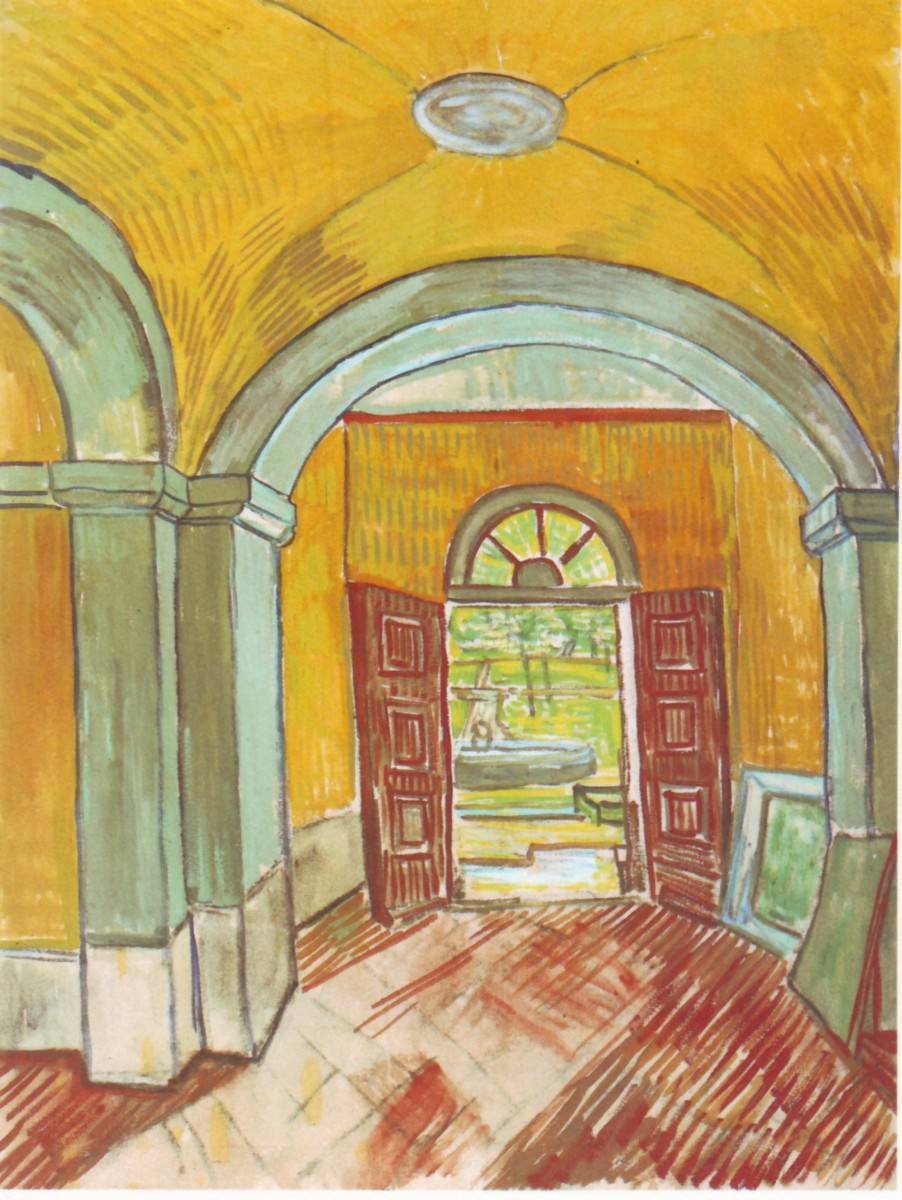
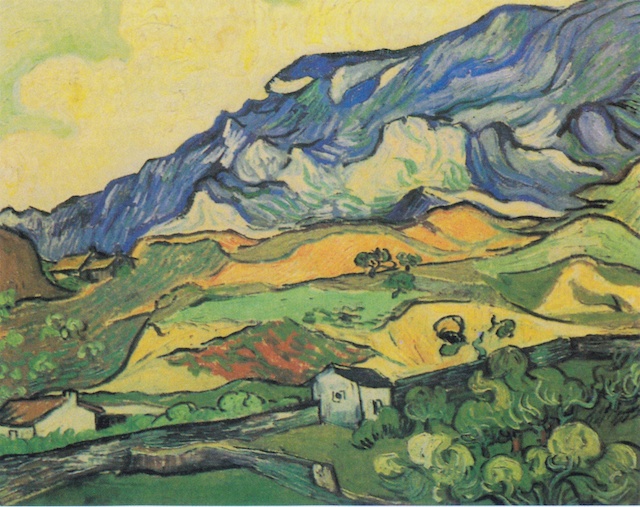
He created some of his most famous paintings during his stay in Saint-Rémy-de-Provence, including:
- “The Irises”,
- “Starry Night”,
- “Olive Grove in the Evening”,
- “Field of Wheat with Cypress Tree”,
- “First Steps”,
- “Reaper in a Field of Wheat”,
- “La Siesta”,
- “The Paving Stone Layers”,
- “St. Paul Hospital”, and
- “Vase of Irises on a Pink Background”
The Transhumance Festival
This quiet town hits its first popular event before the summer rush of tourists even arrives, the Transhumance Festival.
On the morning of Pentecost Day, 3,000 white merino sheep and a few goats and donkeys flood the streets of Saint-Rémy with shepherds dressed in traditional costumes.
The event is one of the most impressive in Provence and always draws a large crowd of tourists and locals who come to watch the enormous parade invading the boulevards that encircle the old town of Saint-Rémy.
The animals are only a small number of millions of sheep and goats which leave the plains of Provence to reach the high pastures of the Alps, where they stay until mid-October. In the past, animals and shepherds travelled by foot for more than ten days.
On the day of the Transhumance Festival, the town of Saint-Rémy also hosts a cheese fair and a flea market.
Monastery of Saint-Paul-de-Mausole
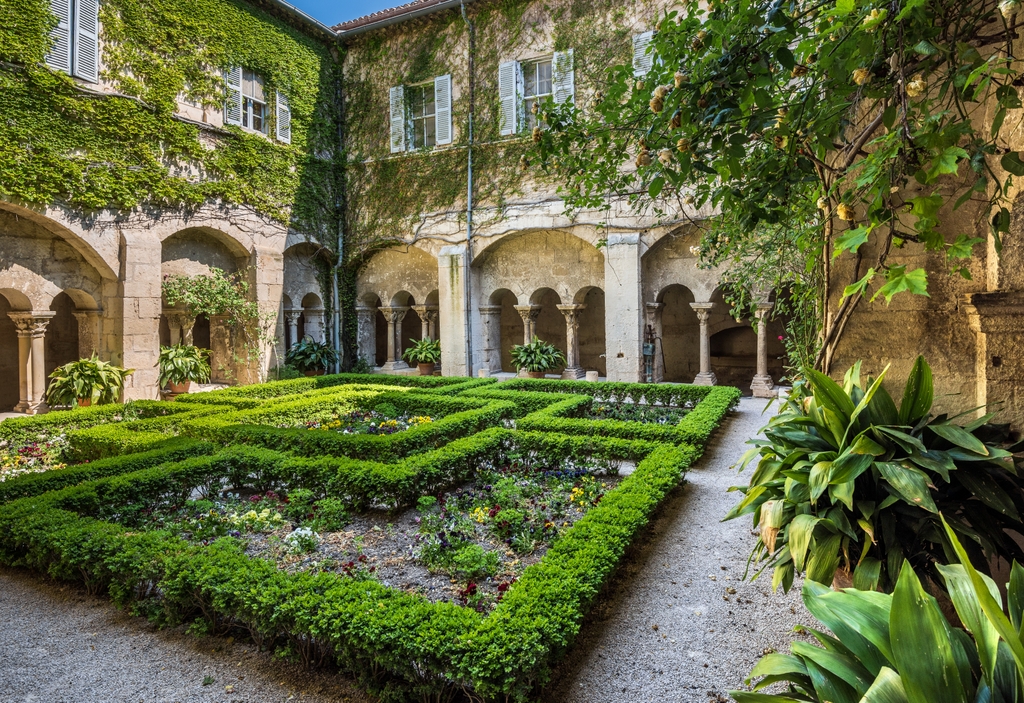
The monastery is another building famous for hosting Vincent Van Gogh in the last years of his life, between 1889 and 1890.
Its name derives from the nearby Roman Mausoleum. Van Gogh’s room is open to visitors, as are the central alley and the Romanesque church.
The estate includes a pretty 12th-century cloister, a masterpiece of Provençal Romanesque art. The intimate cloister is beautiful and peaceful, full of flowering gardens, popular among photographers and Instagrammers.
It currently houses a psychiatric hospital, and, as a result, visiting is subject to the number of people there at any one time to maintain the tranquillity of the place.
Visit the website of Saint-Paul-de-Mausole [in French]
The Roman ruins of Les Antiques

At the feet of the Alpilles and opposite the Monastery of Saint Paul-de-Mausole is Les Antiques, a Roman site consisting of two ancient monuments. The triumphal arch and the mausoleum are amongst the best architectural examples of Roman civilisation in France.
The Triumphal Arch
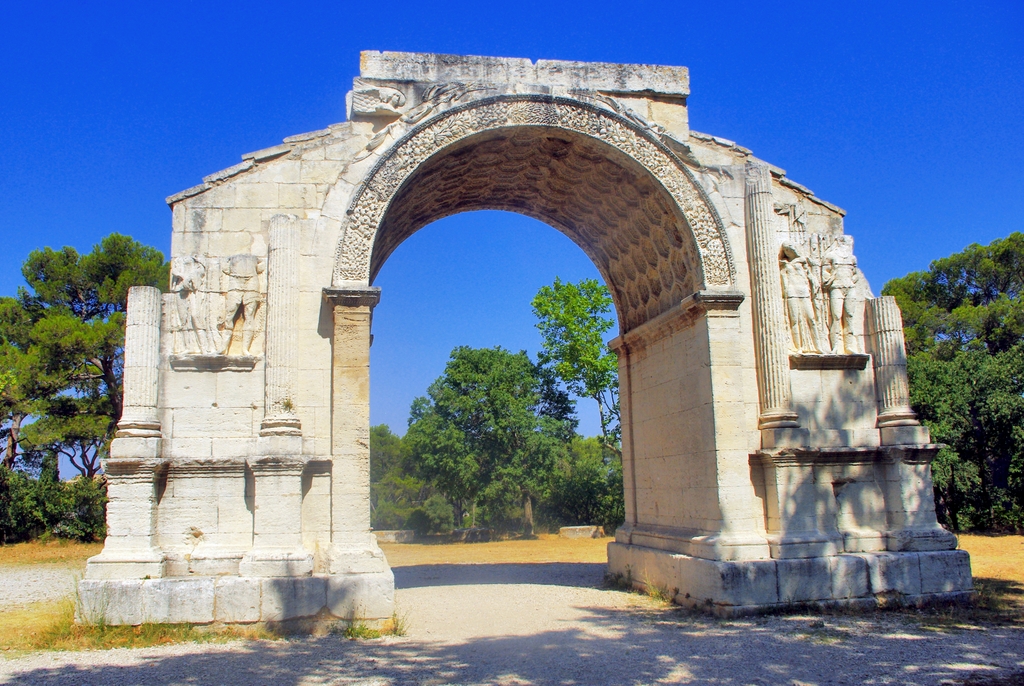
Though the triumphal arch may not be the best preserved in Europe, it is famous for being the oldest from Narbonese Gaul, dating back to the beginning of the 1st century A.D.
The arch has perfect proportions (12.5 m long X 5.5 m wide X 8.6 m high), and its décor denotes a Greek influence. The pediment over the vault has been missing for a long time, and the current flagstone roof is an addition from the 18th century.
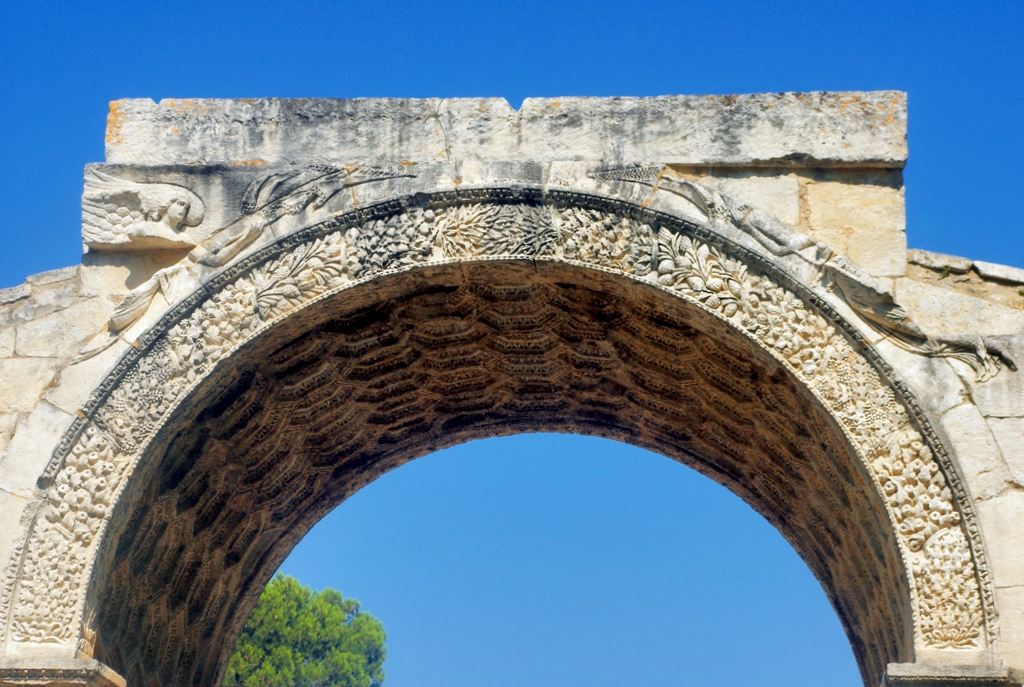
Legend has it that it was built to celebrate the Roman conquest of Gaul by Julius Caesar and stood, at that time, at the entrance of the Roman city of Glanum. Sculptures of fruit and leaves, symbolising abundance, can still be seen bordering the archway, reminding viewers of the success of the Pax Romana.
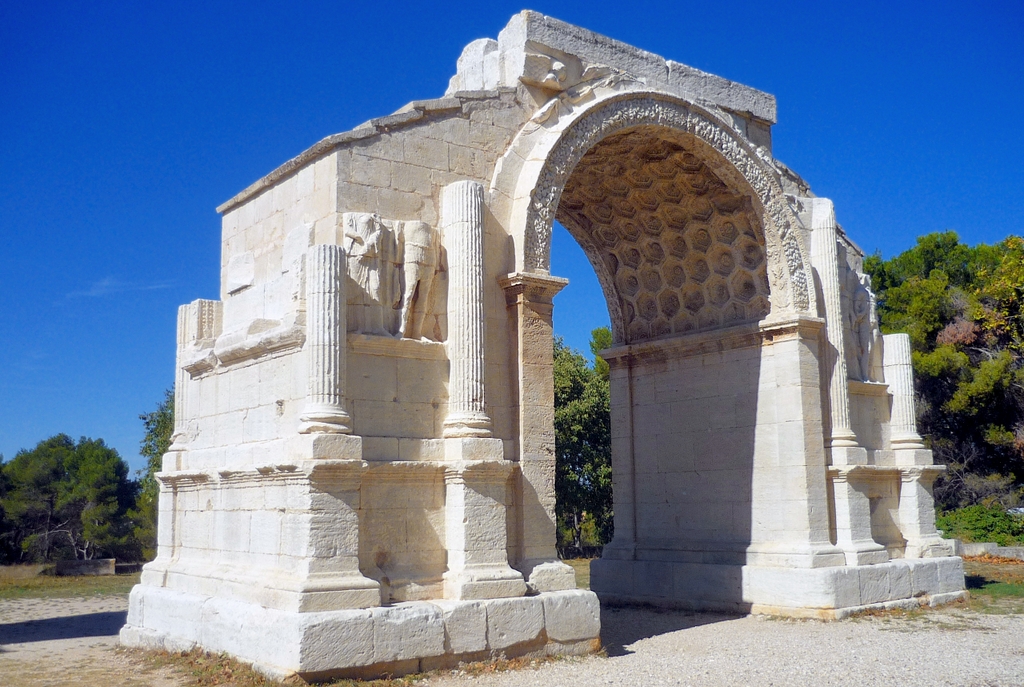
On either side of the arch, between two columns, are figures of chained male and female captives, representing Roman might and strength.
The Mausoleum
The Mausoleum is arguably the most beautiful one of its kind from the Roman Empire, which has survived to our time perfectly intact – apart from the missing pinecone which used to sit atop it. The mausoleum was built in 30-20 B.C. by the Julii. This influential family dedicated the monument to their father and grandfather, who had served in Julius Caesar’s army.
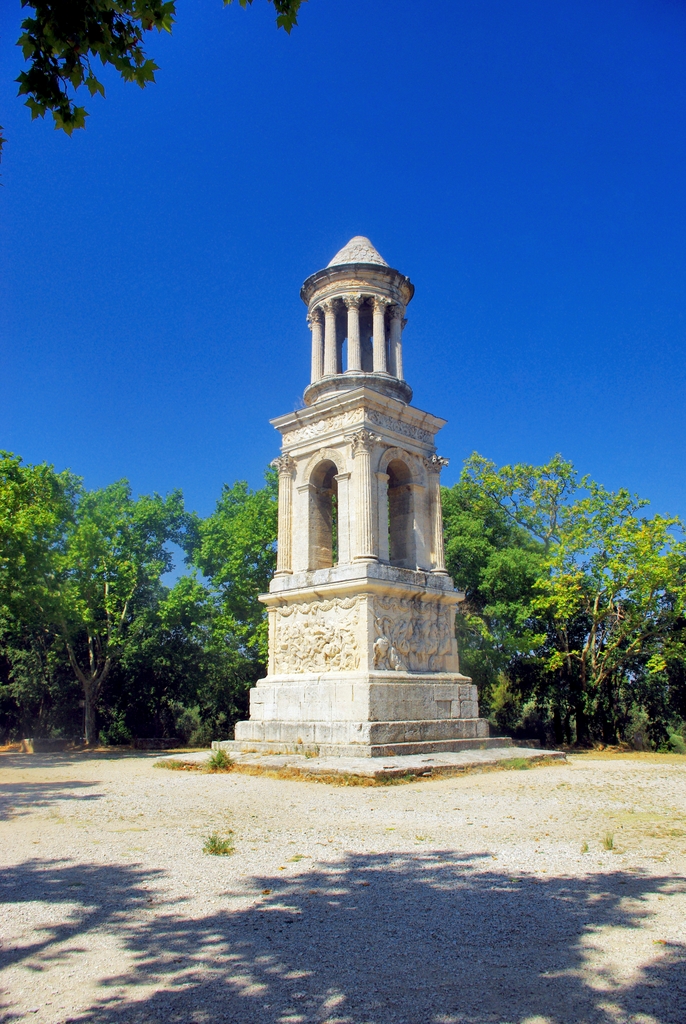
The Mausoleum comprises three levels.
The first is a squared plinth with four sides decorated with bas-reliefs depicting the heroic events of deceased relatives: battles of horsemen and the infantry around a dead warrior, boar hunting and a fighting scene against an Amazon.
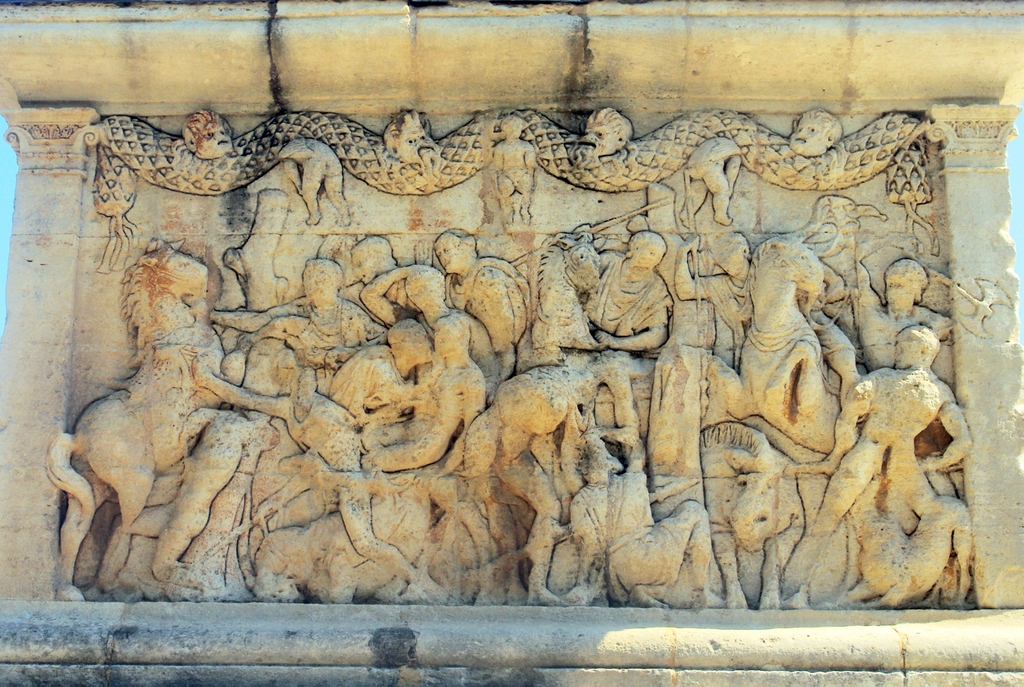
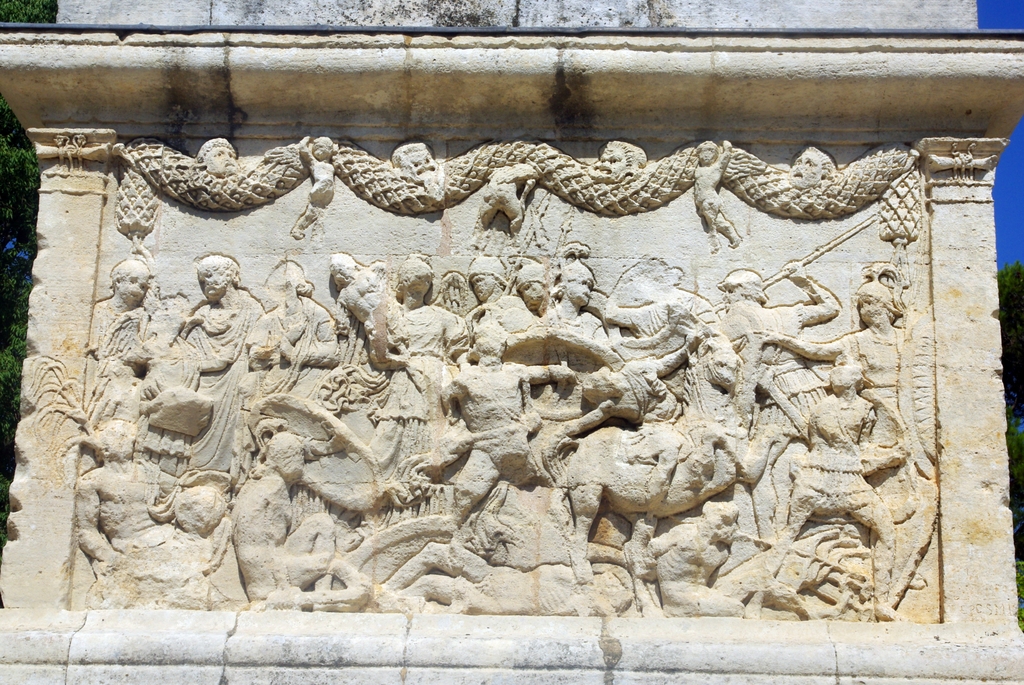
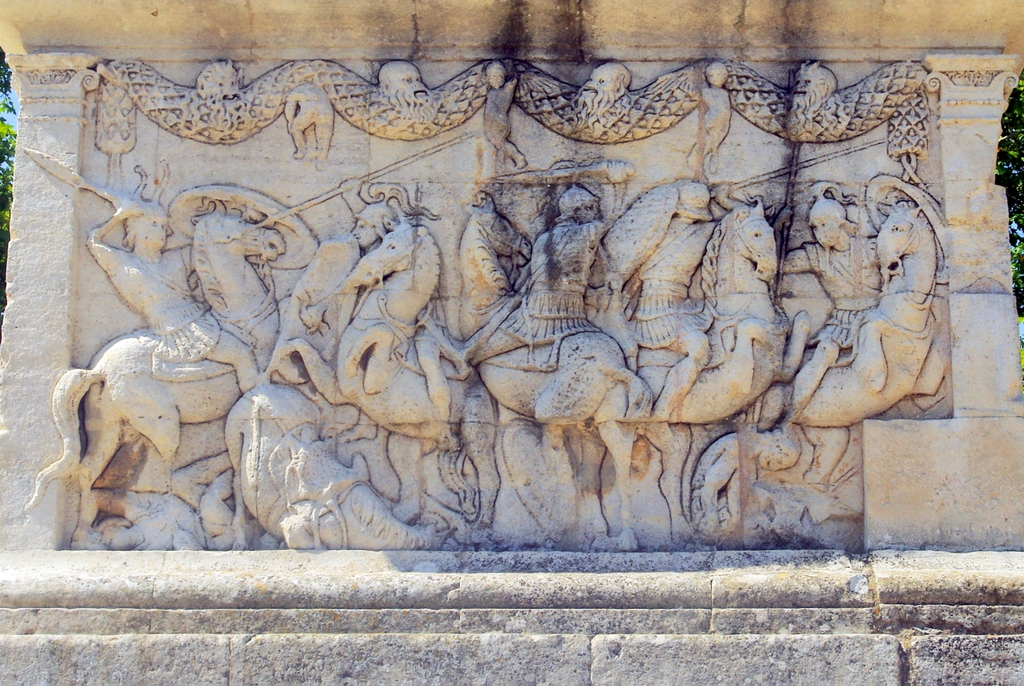
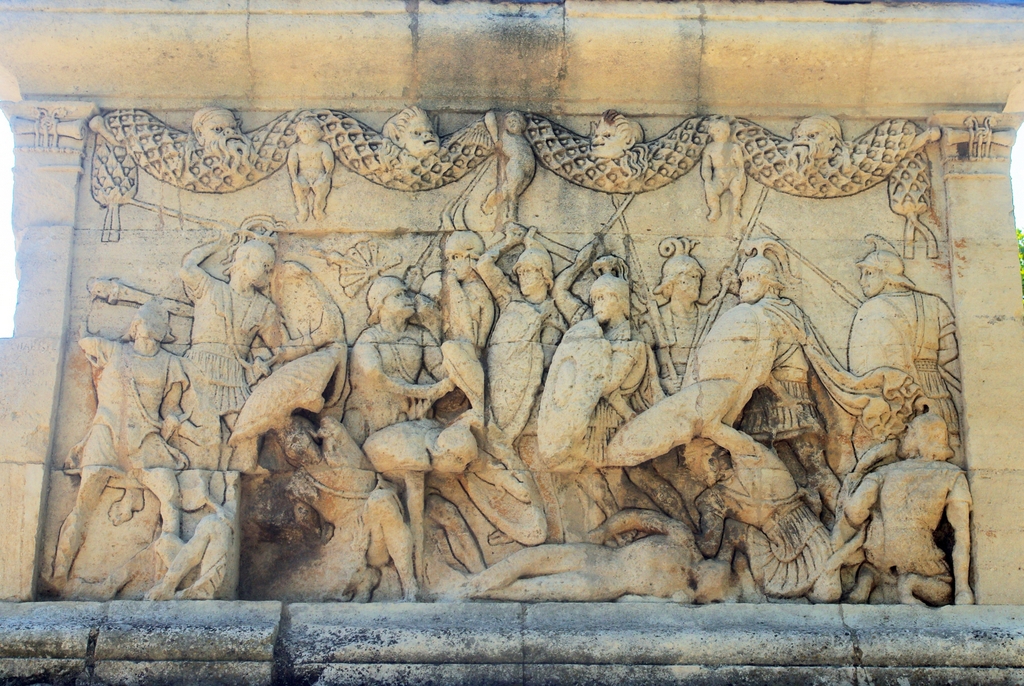
The second level is a triumphal arch with four archways, which explains the link between the later heroic events and Caesar’s victories. The Latin inscription beneath the frieze reads:
“SEX · M · L · IVLIEI · C · F · PARENTIBVS · SVEIS”
(Sextius, Marcus and Lucius Julius, sons of Gaius, to their forbearers).
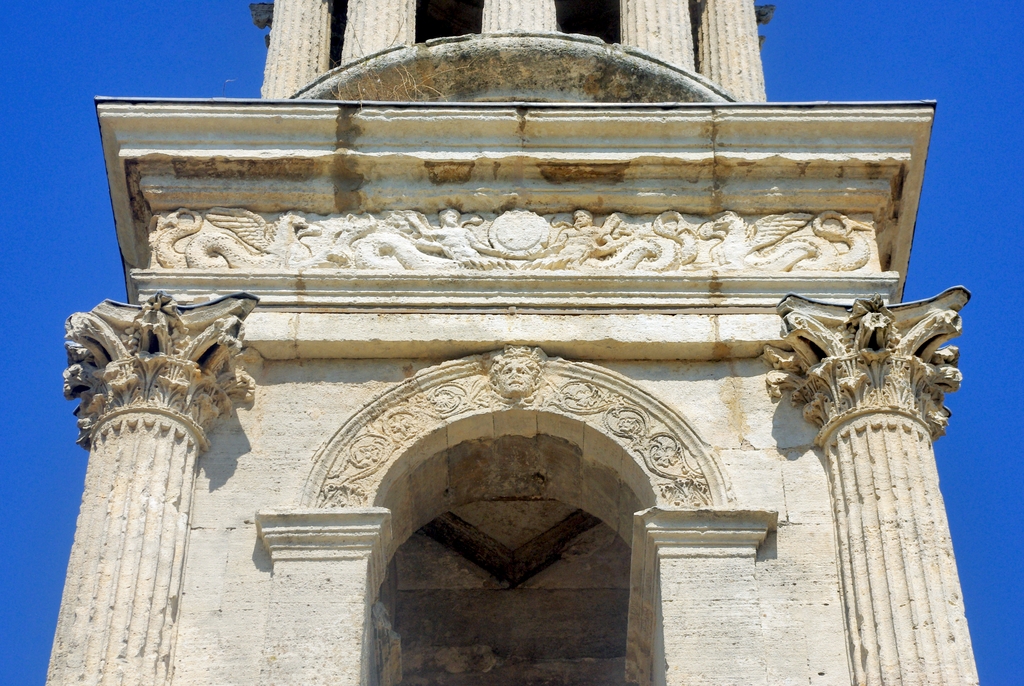
The third and last level consists of a collonaded temple that covers the statues of the deceased.
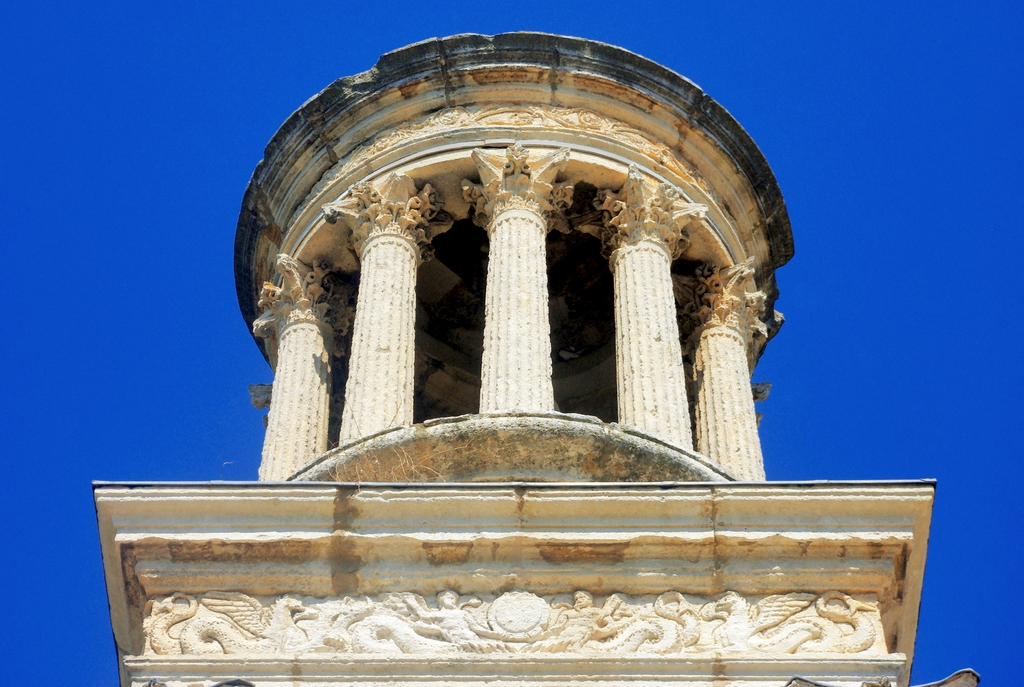
The antique city of Glanum
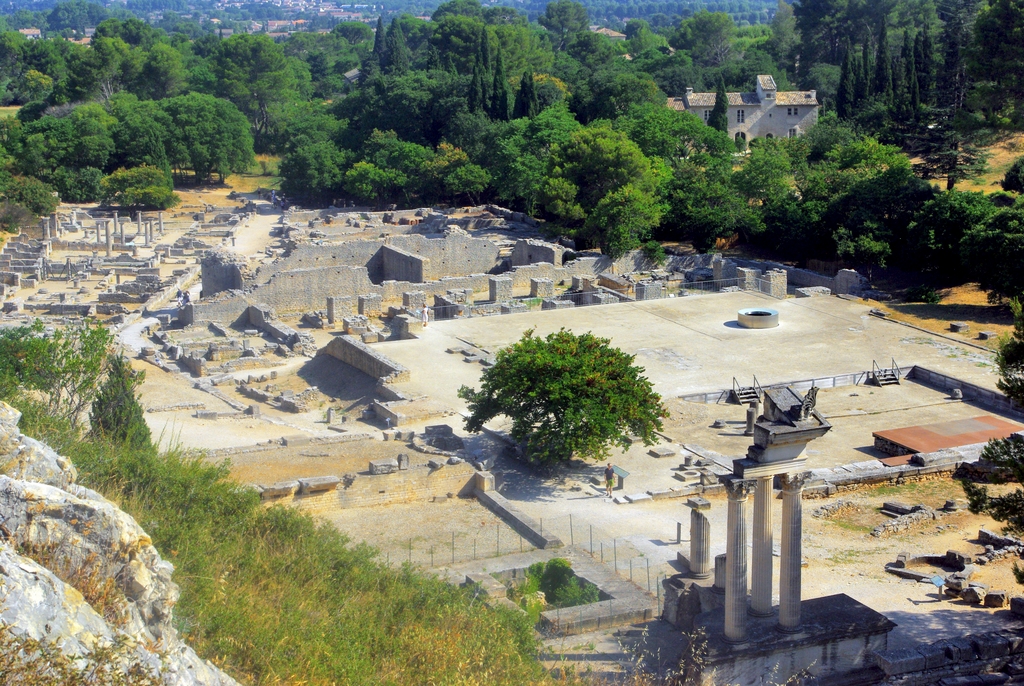
Before Saint-Rémy de Provence existed, the site was known as Glanum.
Located on the flanks of the Alpilles, these Roman ruins makeup one of the oldest and most significant archaeological sites in Europe, along with Vaison-la-Romaine. The Celtic-Ligurians founded Glanum in the 3rd century B.C., well before the Romans conquered the region under Julius Caesar. Glanon – as it was called – was subsequently Hellenised following the trade development with the Greek harbour city of Massalia (Marseilles). The city took its name from Glanic, a Celtic divinity (glann meaning ‘shining’), as it developed around a local spring believed to have healing powers.

Glanon became Glanum during the first century B.C. when it became a Romanised settlement. Under Emperor Augustus, Glanum gained the prestigious status of a Colonia. Residents built new buildings and monuments or enlarged old ones: a forum, various baths, temples, and a basilica, all standing along an extensive residential avenue.
The decline of Glanum
The city was prosperous until the Barbarian Invasions. A raid by the Germanic tribe of the Alamanni destroyed Glanum in 260, and its inhabitants fled, only to settle again a few kilometres north on the plain.
The new town they built, using stones from Glanum, is now Saint-Rémy de Provence. For centuries, nobody knew of the existence of Glanum, and the only Roman monuments visible were the Mausoleum and the Triumphal Arch (Les Antiques).

The rediscovery of Glanum
However, since 1921, archaeologists excavated the site of Glanum, revealing these impressive ruins to the world. Today, visitors can stroll again through the heart of the ancient town along the main street where the foundations of ruined villas stand. There are viewpoints along the path leading to the Gaul sanctuary, give an interesting perspective of the site as a whole.
Visit the official website of Glanum.
How to get to Saint-Rémy-de-Provence

Car
The Alpilles are easily accessible by car from Provence’s main cities, Marseille, Arles, and Avignon, as well as from the cities of Nîmes and Montpellier through an excellent network of motorways, the French “autoroutes”.
Air
If you travel from Australia or America, you could take a flight to Paris Charles de Gaulle, travel by TGV from the airport station straight to Avignon or Aix-en-Provence and rent a car from there. The closest airport is Marseille-Provence.
Train
The TGV from Paris-Gare de Lyon takes less than 3 hours to the TGV stations of Avignon and Aix-en-Provence. There’s no train station in Saint-Rémy. You’ll need to catch a bus from Avignon, Aix-en-Provence or Arles.
More info about Saint-Rémy!
- Watch our guided walk video of Saint-Rémy (23 minutes)
- the Alpilles on the blog
- the best sites to see around Saint-Remy on the blog
- the village of Les Baux-de-Provence on the blog
- The Tourist Board of Saint-Rémy-de-Provence
- The Tourist Board of the Provence region
- A list of hotels and accommodation in Saint-Rémy.
Pin it for later!
Did you enjoy the reading? If so, please share this picture on Pinterest!
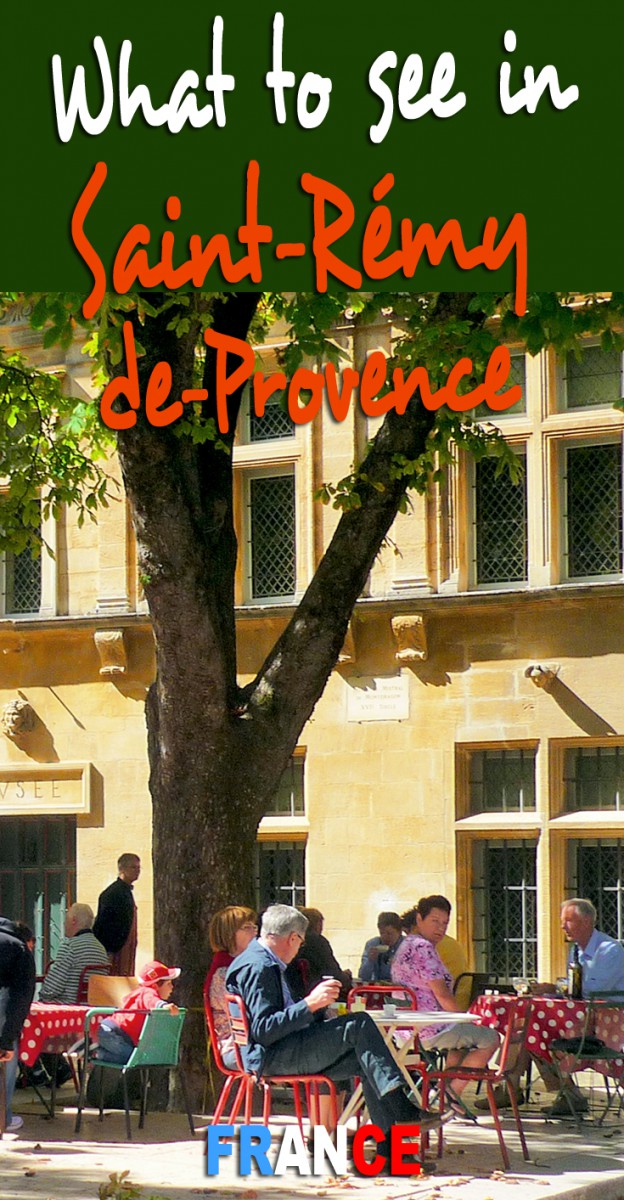


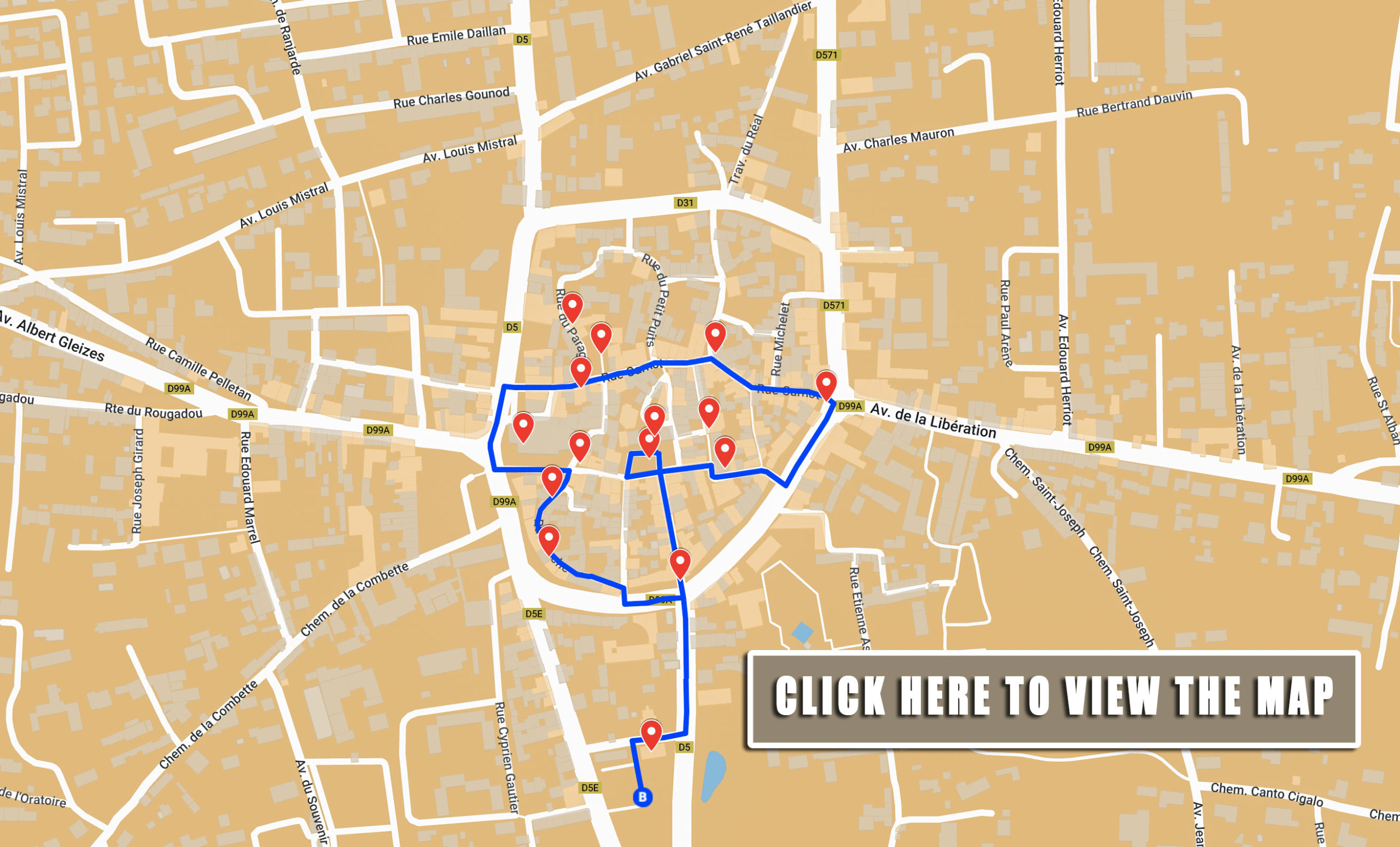



We only returned to Australia two days ago having been fortunate enough to spend a few days in St Remy de Provence a few days before we flew out of Nice. We originally booked there because it was so close to Les Baux de Provence (which we loved) and had no idea it would be as beautiful as it is. We should have planned to stay longer. Your beautiful photos took me right back there. It truly is a very special Provencial town!
Thank you Kathy for your comment. I hope you’ll be able to come back to this beautiful corner of Provence in the future!
Have a nice week 🙂